#it also helps that the next map is relatively straightforward
Explore tagged Tumblr posts
Note
Do you have any proven IBS friendly recipes you'd care to share on The Mind Palate? It's so hard to think of new things to cook when you tolerate like 5 vegetables 🥲.
Btw did you know there's another website called "mind palate", just without the "the"?
As regards IBS: I wouldn't dare share recipes purporting to be useful for other folks with this issue, as every kind of IBS is different. And even for any single IBS-haver, a recipe that's safe for you one week might not be safe for you two weeks later... because the ingredients have varied, or the relative amounts of them have varied, or something you're having with them might differ in ways that throw off their interaction with your gut. :/ This is a pain in the butt, but (shrug) here we are.
To manage my IBS—as there is at present no known cure, no matter what some people claim—I use the well-known Monash University FODMAP-based approach. When I started using it a few years ago—on realizing that some food-related symptoms I was experiencing mapped very closely onto descriptions of IBS symptoms—the abdominal troubles I was experiencing decreased by sort of 95% almost immediately.
The message was too straightforward to ignore. I immediately started adjusting my diet along FODMAP-conscious lines in an Every-Woman-Her-Own-Test-Tube sort of way, and quickly started discovering what gave me the most trouble. (To my intense annoyance, the chief answer to this question, among various others, was "onions and garlic." Two of my absolutely favorite things, and I find it hard to express how INCREDIBLY PISSED OFF this makes me.)
I'm also lactose-intolerant, but for that all I have to do is take a pill. As regards other IBS-triggering foods, there's no known way to stop the bad effects once they start. Some medications will let you offset some of the worst effects in their very early stages... if you take the meds soon enough. But you can't usually tell for sure until six to eight hours or so after a given meal whether "you chose poorly...", and whether you're going to spend the next two to three days bedridden, in more or less constant abdominal pain, and useless for any kind of work.
(sigh) Anyway. I'm fortunately not troubled too much by vegetables as a class.* Though I find (to my intense annoyance) that when I'm lucky enough to be in the right parts of Europe around Spargelzeit, asparagus is pretty much now off my menu. Like many other IBS-managing folk, I do have to be very careful around beans, pulses in general, and some kinds of fruit; and I have to limit my serving sizes/consumption.
(shrug) It's all an ongoing challenge. I had sixty-plus years of eating any damn thing I pleased, in whatever amounts I pleased, whenever I pleased. Now I have to very closely read ingredients labels to make sure there's nothing in a given innocuous-looking bag of snacks that's going to land me on my back for days. :) If it gets no worse than this for me, I'm sure I can cope. I'm just glad I'm in the EU, where detailed ingredients labeling is mandated even for street food stalls, and is also clearer than it is in a lot of other parts of the world.
Meanwhile: I'm sorry not to be of more help to you in this regard. I wish you good fortune in your journey to find safer veggies.
As regards other people's "mind palate" branding and websites: There are five or six different versions of the domain name out there. They don't bother us. I've been a Sherlockian for more than sixty years, and I'll make my puns (from newer variants on the great Theme) where I please. Those other users of the site name or similar domains? (shrug)
*...BTW, it's been brought to my attention recently that a rumor was making the rounds that I'm a vegetarian. (Once again, and not for the first time, wondering how the hell these things get started...?!) 😄 I'm an omnivore, and have never from the beginnings of my time in public life/fandom claimed to be otherwise. (And plainly, no one who's bought into this has ever seen me getting to grips with a steak. Vide this recent steak, last October I think, at Davy Byrnes—"the Moral Pub" as James Joyce once called it—in Dublin. It was yummy. And in the middle of it I had the concept for a really unusual novel occur to me. Meanwhile, that Hollandaise was lovely.)

(...but shrugging in a helpless way about the rumor) Maybe somebody saw me pass on all the meat-ish possibilities at some convention banquet in favor of the vegetarian one? That would simply have been because it looked better than anything else on offer. But right now, because of the IBS, meat and fish are (maybe paradoxically) safest for me. Go figure.
...Meanwhile—all that aside—as a fan of the place's cuisine for many years, I direct everyone's attention to the noble and excellent restaurant Hiltl (known to its fans as Hiltl Vegi), the world's oldest continuously operating vegetarian restaurant, in Zürich: a place old enough for Sherlock Holmes to have eaten there (and where I hope to send him yet). Come for the (predominantly Indian) lunch buffet. Stay for the wine list (one of the best in the city). :)
208 notes
·
View notes
Text
The Atmosverse Discussion, Part 4 - On the Boat
So far we've been introduced to three different 'worlds' in the previous ATMOSPHERE ASMR videos - a medieval fantasy, the Victorian age and the far future. Video #4, originally released on October 8, 2019 and available here, takes us back to the first of those. We've done our introductory tour; now it's time to start developing a narrative...

IN SHORT: We join the same mage from Alchemy in the Forest as she takes a magically-propelled boat across the lake, explaining her purpose on the way.
So here we are, our first recurring character! We still don't get a name for our magical friend, but from the forested landscape surrounding the lake we're still in the same location as the last time we saw her. In these early days of the videos we were still a way off from Anastasia using the WorldAnvil site to post maps of this world, but we're already slowly expanding it. We also still don't know the exact relationship that we, the audience, have with this character, but the explanatory way that she speaks to us suggests that we don't ourselves have the same gifts or knowledge of the area that she does.

This is another relatively short video, but we do get a little bit of character and world building alongside the ASMR triggers. As she talks about her upcoming task and her dislike of talkative people/liars, we get more of an idea of who this mysterious woman is. She's straightforward and fairly no-nonsense, but is clearly someone that the local people can trust to investigate their supernatural problems. There's also a hint that our presence as someone she's spending an extended period of time with (and patiently explaining herself to) is a rarity, and it leaves you wondering how long 'we' have known her.
In terms of construction, the video uses a similar blend of techniques as the first fantasy episode; Anastasia's costume and the single prop - the lantern - grounds her as our focus amidst the digitally-realized boat and lake. It's already slightly more ambitious than that original outing, though, syncing the filmed elements to the movement of the boat in a way that sells the idea. Notice how that movement subtly changes as the boat leaves the dock, crosses the lake and approaches the opposite shore - it's an attention to detail that's going to be one of the hallmarks of these videos.

In terms of the ASMR experience, this is a conversational and environmental piece rather than featuring personal attention or overt trigger use. You have the soft speech (because Anastasia recorded a dub then layered it over the video her words are very slightly out of sync with her lip movements, but rather than detract from the episode it actually helps to create a dreamlike atmosphere that works with the mood) over the soft background noises of the water and the magical boat. Then, once the conversation is over, the rain is brought in to take over as the primary auditory trigger. It's essentially an ASMR video of two halves, the first more focused and the second forming a calming 'downward slope' to the end.

The way that the ATMOSPHERE videos slowly ease the audience into their worlds is so measured and restrained; Anastasia is taking her time to build to what she's envisioned rather than immediately making a bold statement as to what these episodes are going to become and what her aims are. There's no THIS IS WHAT THE STORY IS AND HOW IT'S GOING TO HAPPEN, there's just a gentle demonstration with this fourth instalment that having introduced these three settings, she is going to return to them so that we can spend more time with these characters.
Join me next time as we return to another of our cast members and take a look at how the different kinds of ASMR tropes serve to identify and inform how we see the characters - both the ones on screen and our audience surrogate. See you then, friends!
3 notes
·
View notes
Text
Secure And Convenient
Controlled access entry gives you peace of mind, knowing your home is safe and private. At Amberleigh Ridge, you’ll find one bedroom floorplans in Chattanooga with features that make life both secure and comfortable. Attached and detached garages are available, giving you flexibility for your vehicles and storage needs. Speaking of storage, there’s plenty of private space to keep your belongings organized. High-speed internet access means you can stream, work, or browse without interruptions. If anything goes wrong, the 24-hour emergency maintenance service ensures help is just a call away. Whether you’re looking for a cozy one-bedroom or need more space, these apartments are designed to meet your needs while keeping security and convenience a top priority.
The Transportation System in Chattanooga, Tennessee
Chattanooga’s transportation system is pretty straightforward. Getting around the city is easy, especially if you’re driving. Roads are well-maintained, and traffic isn’t usually a problem, so commuting is relatively stress-free. If you don’t drive, you’ve still got options like buses, which cover most areas. For a small city, public transportation is pretty reliable. The city's also bike-friendly, with some cool bike lanes around town. And if you're into walking, downtown Chattanooga is very walkable, making it simple to get to shops, restaurants, or parks without needing a car. If you do drive, though, parking’s typically not an issue, making getting around even easier.
Tennessee Valley Railroad Museum in Chattanooga, Tennessee
The Tennessee Valley Railroad Museum is a cool spot if you’re into history or just love trains. You can take a ride on a real vintage train and see what it was like back in the day. The museum also has tons of old locomotives and carriages you can check out up close. It’s pretty easy to spend a few hours here, especially if you enjoy learning about the past. They often run special events and themed train rides, so there’s always something fun going on. If you’re traveling with kids or just enjoy unique experiences, this place is a great stop. Plus, it’s all right next to the river, so you can enjoy some nice views too.
Whataburger Coming To Chattanooga In 2025
It’s about time! Whataburger coming to Chattanooga is exciting news for burger lovers. For years, fans in the area have had to make the drive to Scottsboro, AL, or hope for a road trip encounter to get their fix. Now, the city will finally have its own location. While we don’t know exactly where yet, it’s good to see another popular chain expanding in the area. With over 890 locations, Whataburger clearly has a loyal following, and the East Tennessee and North Alabama areas are already familiar with the brand. It’ll be interesting to see how the local market reacts to its arrival. If you’re a fan of hearty burgers, you’ll definitely want to keep an eye out for when they open in 2025.
Link to map
Tennessee Valley Railroad Museum 4119 Cromwell Rd, Chattanooga, TN 37421, United States Get on TN-153 S from Cromwell Rd 3 min (0.9 mi) Continue on TN-153 S to Panorama Dr 6 min (4.5 mi) Follow Panorama Dr to Aventine Way 3 min (0.3 mi) Amberleigh Ridge 7205 Aventine Way, Chattanooga, TN 37421, United States
0 notes
Text
What is lambda function in Python: An Overview?

This lambda function takes one argument “x” and returns its square Lambda functions can also be assigned to a variable or passed as an argument to another function.
How to Define a Lambda Function?
To create a lambda function, start with “lambda”, followed by all function arguments separated by colons, then your desired function body. Here is its basic syntax.
“Arguments” of a lambda function, separated by commas. An “expression” is code that will execute and must return some value as output from its execution.
Imagine we want to define a lambda function which takes two arguments and returns their sum as its output
When and Where to Use Lambda Function
Lambda functions are useful when an immediate one-liner function is required for a task or operation, such as passing arguments to higher-order functions like map (), filter (), and reduce () or functional programming techniques such as metaprogramming. They can also help reduce code clutter while making code more concise.
Lambda functions are ideal when they are only utilized once without a name or when their functionality does not require complex development also developers unfamiliar with lambda functions should remain cautious to avoid creating additional confusion among colleagues who still need to grasp these functions fully. Therefore, it is best to use lambda functions sparingly in situations when necessary for code readability and understandability, otherwise, their potential confusion should become greater than anticipated.
Applications of A Lambda Function in Python
Lambda functions in Python are versatile and have many applications. Here are some examples:
1. Sorting
Python’s sorted () function offers an optional key parameter, used to specify a function that accepts items and returns an index value used for sorting. A lambda function may also be utilized here to help sort objects based on certain properties.
2. Filtering
The filter () function in Python is used to create a new list by selecting elements from an existing list based on a condition. A lambda function can be used to define the condition.
3. Mapping
The map () function in Python is used to create a new list by applying a function to each element of an existing list. A lambda function can be used to define the function.
Pros: Lambda Function in Python:
Lambda functions are convenient tools that enable developers to rapidly create small functions without defining separate ones.
Lambda functions are an efficient way of eliminating code clutter within your script without defining and naming functions only once.
Lambda functions can be used as arguments for other functions, making passing functions around as variables easy and They’re particularly handy if a function needs a specific property set as its criteria for evaluation.
Cons: Lambda Function in Python:
They are intended for straightforward operations and should not be utilized in complex processes.
Lambda functions can be challenging to debug due to their nameless nature, making it harder to spot errors within code.
They can be useful, yet their usage in production code is relatively infrequent, also which makes them harder for other developers unfamiliar with them to grasp.
What Is the Linked List?
A linked list is an index data structure commonly employed in computer science to store collections of elements known as nodes. It consists of a sequence of nodes with data stored inside them and references (pointers) pointing toward the next node after it, along with one final node typically including an indicator stating its end to ensure accurate listing results.
Linked lists may be singly linked or doubly linked, with each node holding references to its immediate neighbor and both previous nodes in both lists.
linked lists have disadvantages such as slower access times for individual elements and increased memory usage due to extra pointers needed per linkage node; on the plus side, they allow insertion/deletion at any position without shifting subsequent elements by shifting all subsequent nodes. Linked lists also suffer due to their slower access times per element and higher memory usage due to their need.
When Should You Use a Linked List?
Linked lists can provide an effective data structure in many situations, from dynamic systems with dynamic requirements, such as queueing systems or engines, to flexible databases requiring dynamic updates.
Linked lists offer dynamic growth or shrinkage capabilities, making them the ideal solution when the amount of stored information remains unclear or can vary over time.
Linked lists allow for efficient addition or deletion at any point within their list, without shifting all subsequent elements out of place. As a result, linked lists make an ideal solution when frequent inserting/deleting occurs.
Linked lists may be more memory efficient than arrays for large data structures, as linked lists only allocate space to data elements and their pointers to the next element; arrays require allocating memory for every possible element regardless of whether any are required or used.
Linked lists can serve as the backbone for several other data structures such as stacks, queues, and graphs. they provide dynamic memory allocation schemes in operating systems.
How to Use Linked Lists in Python?
This implementation utilizes two classes to represent a linked list The Node class defines nodes with two attributes – data and next (which points towards the next node in the list), while Linked List represents it collectively, with the head attributing to the initial node of said linked list also Furthermore, various operations exist, such as adding or prepending to removing from the said linked list as needed adding nodes at either the beginning, middle, or end adds nodes into their proper places at such positions.
Advantages of Linked Lists
Linked lists offer dynamic growth or contraction during runtime, unlike arrays with fixed sizes, making them suitable for situations where data storage needs are unknown or fluctuate over time also This makes linked lists particularly suitable when data volumes vary significantly and must be managed accurately.
Link lists are ideal in situations that demand frequent additions or deletions. Their ability to insert or delete elements efficiently without disrupting subsequent elements makes them ideal.
Linked lists may be more memory efficient for large data structures than arrays since only memory allocated for data elements and pointers to the next element needs to be allocated when using linked lists, while arrays require allocation for an equal number of elements regardless of usage.
Cache memory management schemes provide the basis for other data structures, including stacks, queues, and graphs dynamic memory allocation schemes in operating systems may be them.
Linked lists are easy to implement and understand, making them an excellent way for beginner programmers to explore data structures.
Disadvantages of Linked Lists
Accessing individual elements within a linked list may be slower than arrays due to each element needing to be sequentially accessed starting from its head of the list and potentially slowing performance for applications requiring frequent random access.
Memory must also be allocated for the pointers to each element in an array, leading to more memory overhead for these structures and becoming an issue when dealing with large data structures This becomes even more of an issue when working with large datasets.
Indexing elements isn’t efficient; accessing an element at a particular index number requires iterating through all of them – which may lead to a lower performance for apps that need frequent indexing.
Reversing traversal in singly linked lists may be challenging or inefficient because each node only provides access to its next node rather than the previous node also making this approach inapplicable in certain applications requiring frequent backtracking.
Merging or sorting linked lists is often more challenging and time-consuming than working with arrays, as this requires traversing each node individually to rearrange them in their proper order.
Conclusion
Lambda Function is Understanding the difference between the population and the sample is integral for statistical analysis Population refers to all individuals, objects, or events we want to investigate while sample refers to a smaller subset that we select for further examination also Studies that employ samples as part of their methodology often find it impossible or impractical to survey an entire population directly; nevertheless also it remains essential that any selected sample represents and it accurately for valid conclusions about that population to be drawn from its data and Sampling techniques and sample size determination play an essential part in assuring the representativeness of samples taken, therefore an in-depth knowledge of the population and sample is imperative to avoid bias and ensure validity and reliability in statistical analyses.
Source: Click Here
#best btech college in jaipur#top engineering college in jaipur#best btech college in rajasthan#best private engineering college in jaipur#best engineering college in rajasthan#best engineering college in jaipur
0 notes
Text
How to Use Python Lambda Functions - ACEIT
What Is A Lambda Function In Python?
lambda x: x**2
This lambda function takes one argument “x” and returns its square Lambda functions can also be assigned to a variable or passed as an argument to another function.
How To Define A Lambda Function?
To create a lambda function, start with “lambda”, followed by all function arguments separated by colons, then your desired function body. Here is its basic syntax.
“Arguments” of a lambda function, separated by commas. An “expression” is code that will execute and must return some value as output from its execution.
Imagine we want to define a lambda function which takes two arguments and returns their sum as its output
When And Where To Use Lambda Function
Lambda functions are useful when an immediate one-liner function is required for a task or operation, such as passing arguments to higher-order functions like map(), filter(), and reduce() or functional programming techniques such as metaprogramming. They can also help reduce code clutter while making code more concise.
Lambda functions are ideal when they are only utilized once without a name or when their functionality does not require complex development also developers unfamiliar with lambda functions should remain cautious to avoid creating additional confusion among colleagues who still need to grasp these functions fully. Therefore, it is best to use lambda functions sparingly in situations when necessary for code readability and understandability, otherwise, their potential confusion should become greater than anticipated.
Applications Of A Lambda Function In Python
Lambda functions in Python are versatile and have many applications. Here are some examples:
Sorting
Python’s sorted() function offers an optional key parameter, used to specify a function that accepts items and returns an index value used for sorting. A lambda function may also be utilized here to help sort objects based on certain properties.
Filtering
The filter() function in Python is used to create a new list by selecting elements from an existing list based on a condition. A lambda function can be used to define the condition.
Mapping
The map() function in Python is used to create a new list by applying a function to each element of an existing list. A lambda function can be used to define the function.
Pros: Lambda Function In Python:
Lambda functions are convenient tools that enable developers to rapidly create small functions without defining separate ones.
Lambda functions are an efficient way of eliminating code clutter within your script without defining and naming functions only once.
Lambda functions can be used as arguments for other functions, making passing functions around as variables easy and They’re particularly handy if a function needs a specific property set as its criteria for evaluation.
Cons: Lambda Function In Python:
They are intended for straightforward operations and should not be utilized in complex processes.
Lambda functions can be challenging to debug due to their nameless nature, making it harder to spot errors within code.
They can be useful, yet their usage in production code is relatively infrequent, also which makes them harder for other developers unfamiliar with them to grasp.
What Is The Linked List?
A linked list is an index data structure commonly employed in computer science to store collections of elements known as nodes. It consists of a sequence of nodes with data stored inside them and references (pointers) pointing toward the next node after it, along with one final node typically including an indicator stating its end to ensure accurate listing results.
Linked lists may be singly linked or doubly linked, with each node holding references to its immediate neighbor and both previous nodes in both lists.
linked lists have disadvantages such as slower access times for individual elements and increased memory usage due to extra pointers needed per linkage node; on the plus side, they allow insertion/deletion at any position without shifting subsequent elements by shifting all subsequent nodes. Linked lists also suffer due to their slower access times per element and higher memory usage due to their need.
Read Full Blog : Arya College
0 notes
Text
The Monogatari Series, Nonlinear Storytelling, and Arc-Weaving
Over the past half-year or so, I've gotten pretty into the Monogatari series. Or, more precisely, into the first three seasons thereof, since that's the current end-point both of the English-translated novels and of the anime. The series has a lot of interesting stuff going on—I wouldn't be surprised if I ended up making several posts about it over the next while—but one thing it does which strikes me as particularly warranting analysis, for purposes of extracting its techniques for use in my own writing, is its employment of nonlinear storytelling.
(Below the cut: Monogatari series spoilers through the end of the third season (also known as the Final Season).)
1. Introduction
The Monogatari series, over the course of its first three seasons, is very aggressively nonlinear. Chronologically, if we oversimplify somewhat by ignoring framing stories and pretending that each book takes place at a single point in the timeline whenever we can get away with doing that, we end up with this mapping between reading order and chronological order:
Bakemonogatari, Part 1 (chronologically #3)
Bakemonogatari, Part 2 (chronologically #4)
Kizumonogatari (chronologically #1)
Nisemonogatari, Part 1 (chronologically #5)
Nisemonogatari, Part 2 (chronologically #6)
Nekomonogatari (Kuro) (chronologically #2)
Nekomonogatari (Shiro) (chronologically spans the range from #7 to #9 (inclusive))
Kabukimonogatari (chronologically #7)
Hanamonogatari (chronologically #17)
Otorimonogatari (chronologically #11)
Onimonogatari (chronologically #8)
Koimonogatari (chronologically #12)
Tsukimonogatari (chronologically #13)
Koyomimonogatari (chronologically scattered, covering points throughout the span between 1 and 13, with its ending being chronologically #14)
Owarimonogatari, Part 1 (chronologically #10)
Owarimonogatari, Part 2 (chronologically #9)
Owarimonogatari, Part 3 (chronologically #15)
Zoku Owarimonogatari (chronologically #16)
...so, of seventeen books-which-follow-other-books, only a total of four take place straightforwardly immediately after the prior book in the reading order, and two of those four are Bakemonogatari and Nisemonogatari's respective Part 2s, which arguably shouldn't even count, since there's a decent argument to be made that the splits there (particularly the Bakemonogatari one) are purely a product of publishing logistics rather than of true narrative structure.
(Unlike Owarimonogatari, whose parts' separation is very much structural and clearly not just a publishing limitation.)
The first important thing to note about this nonlinearity is that it works. It actively bolsters the quality of the narrative, relative to what a more straightforward chronological rendering would do. And, sure, nonlinear storytelling is done to some extent all over the place, but I've rarely seen it employed as effectively as the Monogatari series employs it on the scale that the Monogatari series employs it at. Which leads to a natural question: what, exactly, is Monogatari doing which would make this superficially-horribly-tangled mess actually sensible as a way of ordering its narrative?
To state my major theses in advance: the nonlinearity of the Monogatari series serves at least three major functions, in addition to probably various more which I have yet to identify. First: it serves as a way to ensure that there are almost always outstanding mysteries and hanging plot threads, thus helping to keep viewers engaged even at points in the timeline where the characters are experiencing their lives as primarily episodic. Second: it allows characters' true natures to be unveiled in a relatively slow and gradual fashion, even in cases where, chronologically, it would become clear relatively early on what their deals are. And third: it allows for interweaving of multiple plot arcs in such a way as to control macro-scale narrative intensity through micro-scale decisions of which arcs to focus on at a given point.
With that bit of signposting out of the way, let's dive into details!
2. Loose Plot Threads
Throughout the three seasons under examination here, there are a grand total of three books after which a reader might reasonably feel like all established mysteries and plot threads have been resolved: Nekomonogatari Kuro, Owarimonogatari Part 3, and Zoku Owarimonogatari. Aside from those three, at any given point in time, there are always things kept conspicuously mysterious:
Bakemonogatari Part 1 establishes Araragi's history with Shinobu over spring break, and Hanekawa's history with the cat that enchanted her over Golden Week, as hanging threads of Backstory Mystery; the former isn't explained in detail until Kizumonogatari, while the latter isn't explained in detail until Nekomonogatari Kuro.
Nekomonogatari Shiro establishes a whole gigantic pile of mysteries regarding Araragi's offscreen adventures. Did Hachikuji ever get her backpack back? Why was Araragi missing from school? What did he need Kanbaru's help with? What broke his connection to Shinobu? What were Gaen, Episode, and Ononoki doing in town? Under what circumstances did Araragi ended up equipped with Kokorowatari while wearing shredded clothes? Et cetera. These get resolved only slowly via drip-feed over the course of Kabukimonogatari, Onimonogatari, and Owarimonogatari Part 2.
Kabukimonogatari establishes the mystery of what Ougi's deal is; subsequent books, particularly Otorimonogatari and Onimonogatari and Koimonogatari, deepen the mystery; it gets resolved only in Owarimonogatari Part 3.
Otorimonogatari establishes the mystery of what's up with the snake-god-talisman in Araragi's room, as well as the mystery of how we saw him alive and Senjougahara and Shinobu discussed-as-though-alive post-graduation in Hanamonogatari despite Nadeko's intention to kill the three of them; these are both only resolved in Koimonogatari.
...et cetera.
What all of this amounts to is that, from the moment they figure out the pattern where the Monogatari series is reliable in eventually filling in whatever plot threads it leaves open, readers will be driven forward in their reading, not just out of interest in the current plot-episode, but also out of interest in learning the answers to those previous hanging mystery-threads. They'll be driven forward this way even during moments when, from the chronological perspective through which the characters are viewing things, events are happening in a relatively episodic fashion, routinely resolving without obvious hanging threads.
That point about 'from the moment they figure out the pattern', incidentally, is among the reasons the first season is as structurally important as it is: in addition to its role in character-establishment, it also fills the crucially-important role of teaching the readers that those loose threads will eventually be returned to and tied off. If not for the first season ending the way it does, with Nekomonogatari Kuro tying off the last of the major loose mystery-threads, audience members might well read Nekomonogatari Shiro and go "huh, guess Araragi is having a bunch of offscreen adventures" and leave their thinking off there, rather than regarding them as the mysteries-to-be-eventually-resolved that they in fact are.
This, then, is one advantage the Monogatari series gains from its nonlinearity: the nonlinearity serves as a source of long-running mysteries, and thereby increases narrative engagingness for those inclined in the direction of trying to solve a story's mysteries as they read.
3. Slow Unveiling of Characters
Separate from the matter of plot-level mysteries as discussed in the prior section, the Monogatari series also uses its nonlinear story-ordering in order to establish and develop character-level mysteries. There's some sense in which the two are closely related; but there's another sense in which they're very different, because character-level mysteries tend to be written differently from plot-level mysteries, with more focus on the introduction of many successive levels of greater detail, rather than a single decisive moment of "ah, this now makes perfect sense".
Let's use two examples as models here: Hanekawa Tsubasa and Oshino Ougi. Various other characters are, to one extent or another, handled similarly, but those two are, I think, the most clear and blatant examples of the thing.
Hanekawa Tsubasa is established more-or-less immediately as, to put it in TV Tropes terms, The Ace. A class president among class presidents, who, despite always denying knowing everything, sure does seem to know a whole lot, even to the point of occasionally responding directly to Araragi's internal monologue without waiting for him to verbalize it first. (Although this habit of hers is sadly omitted from the anime.)
In her first in-focus arc, Tsubasa Cat, we get hints of prior events in Golden Week, we learn more of her limits, and we learn of her love for Araragi; but we learn relatively little about the deeper details of how she works or what makes her tick. Kizumonogatari shows more of her personality and her relationship with Araragi, but once again teaches us relatively little about her internal state. That information on her internal state is instead successively doled out over the two Nekomonogatari stories, with Kuro showing more of her family issues and making explicit her tendency to act in whatever fashion she parses as Correct and Virtuous irrespective of considerations that might make others do otherwise, and Shiro making explicit her tendency towards repressing whatever negative feelings she might have about everything, her inability to ask for help, and in general most of what's left to show of her personality and flaws, just in time for readers to have full context on what's happening and why it's significant when she has her Big Character-Development Moment at the end.
As written, this is a highly-effective slow unveiling of how she works as a character. And, importantly, it wouldn't have worked as well, if it were told chronologically. Kizumonogatari shows us more of her than Bakemonogatari does, and Nekomonogatari Kuro, in turn, shows us more of her than Kizumonogatari does. Her story, presented chronologically, would thus have had a flat spot around Tsubasa Cat, in which she receives noticeably less development than she does in Nekomonogatari Kuro. By going nonlinear in the telling of Hanekawa's story, we instead get a nice smooth curve of escalatingly-detailed establishment of her character in each of her in-focus arcs.
Where Hanekawa's slow unveiling is largely of her flaws, Oshino Ougi's slow unveiling is different: it's largely about her motives. When we first meet Ougi, it's in the flashforward at the start of Kabukimonogatari, chatting with Araragi about traffic lights; we get to see something of her personality right away, in that conversation, but we learn very little of her larger role in things. in Hanamonogatari, Ougi spends his appearance similarly, making idle conversation and introducing Kanbaru to the Lord Devil rumor-set; but this time there's a bit more focus put on how it's odd how quickly he integrated himself into Araragi's social sphere. And, early on in Otorimonogatari, we get a similar-seeming conversation between her and Nadeko, this time with attention drawn to her being familiar with Nadeko but not vice versa.
But it's only near the end of Otorimonogatari that we get to see Ougi in clear goal-pursuit mode: telling Nadeko about the talisman in Araragi's house, and giving her the scrunchy which ends up serving as the basis for Kuchinawa-san. From there, her appearances continue being much more ominous: drawing parallels between herself and the Darkness in Onimonogatari, tailing and sending a deranged middle-schooler after Kaiki in Koimonogatari* (and having it confirmed that her supposed identity as Oshino Meme's niece is a lie), having her blatantly-mocking conversation with Araragi in Tsukimonogatari while he continues to entirely fail to recognize her as a potential threat (as well as being implied to have been the one to set the Tadatsuru situation into motion), et cetera.
Finally, in Owarimonogatari Part 1, we get to see her in full focus, finally showing up as a main character rather than just a side character, and to see more of what it is that she's doing with Araragi, forcing him to confront the various memories that he'd prefer to leave repressed. And this all leads up to Owarimonogatari Part 3, where her true nature is finally unveiled in the course of her big confrontation with Araragi.
Viewed chronologically, Ougi's trajectory of development would be far less interesting. Without the setup of her initial mildly-suspicious-but-not-obviously-antagonistic appearances, there wouldn't be the same degree of impact when her status as actually-an-antagonist is revealed at the end of Otorimonogatari and driven home over the next few books. (And she is, very much, blatantly antagonistic over the course of Owarimonogatari Part 1, even if her antagonism in that case might not have had as much in the way of dire consequences as it did in Otorimonogatari.)
Moreover, told chronologically, much like Hanekawa's, her arc would have felt lopsided: she's get a single big appearance at her introduction, then spent a while being ominous and occasionally causing trouble in the background, and then... suddenly come into focus as the Big Final Antagonist of the Final Season? Whereas, by presenting her appearances nonlinearly in the way they do and leaving her chronologically-first appearance for the start of Owarimonogatari, the novels instead build her up in a proper slowly-escalating trajectory: she starts out as a mysterious character who will probably be important later, advances from there to an antagonist moving against Araragi in the background for still-largely-mysterious purposes, and then advances from there to an actively-in-focus antagonist whose motives are slowly becoming clearer, leaving her spot in the Big Final Antagonist role as a natural culmination of the patterns of narrative escalation surrounding her up to that point.
While Hanekawa and Ougi are, to my eyes, the two most clearly illustrative examples of the pattern, they are by no means the only examples. Similar pictures could be drawn around Kaiki (Hanamonogatari setting up his soft spot for Kanbaru in time for it to factor naturally into his actions in Koimonogatari), around Araragi himself (see e.g. how late we learn about the origins of his justice-related cynicism), on a smaller scale around Oikura Sodachi (it happens within a single book, there, but there's still a definite nonlinearity to how she gets developed within that book), et cetera.
This, then, is another major benefit the Monogatari series gets from its nonlinearity: by establishing and developing its characters in a chronologically-nonlinear fashion, it ends up able to smooth out the trajectories of said establishment/development, to make each step feel satisfyingly escalatory from the last in a way that wouldn't be practical if those trajectories were additionally constrained by chronology.
4. Arc-Weaving
Although the series as a whole is, as discussed in the introduction, aggressively nonlinear, there's an alternate angle by which to look at it under which it appears somewhat more linear: that of the narrative arc. Consider these three major arcs:
Shinobu's past comes back to haunt her. (Kabukimonogatari, Onimonogatari, Owarimonogatari Part 2, also sort of marginally Nekomonogatari Shiro)
Sengoku Nadeko causes trouble. (Otorimonogatari, Koimonogatari)
Oshino Ougi causes trouble. (Otorimonogatari, Koimonogatari, Tsukimonogatari, the final parts of Koyomimonogatri, Owarimonogatari Part 1, Owarimonogatari Part 3)
...and note that all of these arcs are actually primarily linear. The only points of nonlinearity in these arcs are Owarimonogatari Part 1 in the Ougi arc and the very small Shinobu-focused bit in Nekomonogatari Shiro; aside from those two, these arcs are presented entirely in chronological order.
(And, indeed, between these three arcs, we end up touching on the majority of the books in the second and third seasons, excepting only Hanamonogatari and Zoku Owarimonogatari (since those two both take place after these three arcs are already concluded, and serve other narrative functions instead).)
So, in a sense, one could view the Monogatari series as actually relatively light on nonlinearity, at least within the second and third seasons. Rather, in this framing, what it's doing is telling several approximately-linear stories in parallel with one another.
I wouldn't say that that view is the One Correct View into the Monogatari series's nonlinearity, or anything. But I would say that it's a useful view into it. Because this view opens up the question: okay, so we've got these three arcs, each of different length in number-of-books, each taking place over a different chunk of the timeline (even if the beginnings of the Ougi arc happen to be concurrent with the entirety of the Nadeko arc). Why are they intertwined the way they are? What advantage is gained, narratively, by intertwining them instead of telling them sequentially? We established in the previous section why Owarimonogatari Part 1 belongs where it does, sure; but why not tell these stories in chronological order aside from that one divergence therefrom, with all the Shinobu's-past stories coming before all the Nadeko-and/or-Ougi-causes-trouble stories?
Well, one reason is the one discussed two sections ago, about leaving mysteries open to drive continued reader curiosity. But another is this:
As a narrative arc goes on, its intensity tends to increase. Not in a continuous fashion—standard trajectory tends to look more like "start at intensity I, escalate to I + 4, drop down to I + 2, escalate to I + 6, et cetera"—but still very much in a fashion which leads to a clear increase in intensity over time, with the arc ending soon after it hits its highest point intensity-wise. When arcs don't do this, when their highest-intensity points sit more towards their middles than towards their ends, this tends to reduce their overall effectiveness. As a corollary of this, the longer a narrative arc goes on, the more intense it tends to be—and needs to be, to land optimally—by the time of its conclusion. However, longer arcs often take longer to initially get moving, compared to shorter ones.
(See, in this very set of examples, the Ougi arc, and how much longer it takes to get moving actively compared with the other two.)
The Monogatari series has these different arcs, each with their own varyingly-fast rates of escalation and varyingly-intense conclusions. But it also has a separate structural factor at work: its seasons. While the first season is doing something else, the second and third seasons each follow an escalatory trajectory not so different from the one I was just ascribing to individual plot arcs: start relatively slow, escalate as things move forward towards the season finale, and then end once said finale is passed, leading into the next season, which starts and ends at a somewhat higher level of intensity.
(I am, here, counting Owarimonogatari Part 3, rather than Zoku Owarimonogatari, as the third season's finale. NISIOISIN himself, in the Zoku Owarimonogatari afterword, describes Zoku Owarimonogatari as a "bonus installment", with Owarimonogatari Part 3 as "the actual final volume"; as far as this structure of escalation-over-the-course-of-the-season goes, I'm in complete agreement with him.)
What interweaving the separate arcs enables, then, is a far more fine-grained level of control over narrative intensity at the season level. Both seasons' finales coincide with an arc finale, to lend them proper intensity: the second season with Koimonogatari resolving the Nadeko arc, the third season with Owarimonogatari Part 3 resolving the Ougi arc. But the third season, remember, is trying to escalate its intensity to a higher level than that of the second. So the second season finale coincides with the finale of a relatively-short arc, two books long, and this is impactful. But the third season finale coincides with the finale of a six-book arc, and, moreover, immediately precedes this with the finale of the Shinobu arc. Owarimonogatari Part 2, placed elsewhere, could easily have been season-finale-tier material in its own right; but, instead, it's used as an escalatory step by the third season, a prelude to the true finale of Owarimonogatari Part 3.
And this works! It works excellently! Koimonogatari makes for a highly satisfying ending to the second season, resolving the previously-built-up tension with Nadeko plus giving us Kaiki's highly-entertaining narration plus stepping things forward on the Ougi front; Owarimonogatari Part 3, meanwhile, is one of the most impactful finales I've encountered anywhere, not even just in the Monogatari series, serving as the culmination of essentially everything up to that point, feeling properly escalatory even coming on the heels of Owarimonogatari Part 2 and its own status as a highly-built-up arc finale.
So, in short, by carefully controlling the rate at which each individual arc is advanced, the Monogatari series ends up in a position of far more fine-grained control over the intensity of its overall interwoven narrative; it then proceeds to use this control in order to maximize the impact of each season's later portions—ending the second season with the middle of the Shinobu arc followed by the end of the Nadeko arc, and the third season with the middle of the Ougi arc followed by the end of the Shinobu arc followed by the end of the Ougi arc (followed by Zoku Owarimonogatari, which isn't really part of this pattern)—all without doing anything to undermine the impact of the individual arcs as individual arcs. It's a beautifully-elegant trick—one I'm not sure I've ever seen used anywhere else, and which I definitely haven't recognized anywhere else—and one that I very much hope to incorporate into my own writing some day.
Conclusion
This is, for the moment, as far as I've gotten in picking apart what it is that makes the Monogatari series's structure (over the span of the first three seasons, at least) work as well as it does. It seems likely that I'm missing things, still; it would be surprising, if I managed to get everything, especially given having only been thinking on the topic for a couple months thus far.
(As of even just a month ago, I hadn't yet figured out the slow-character-unveiling part; I expect there are other similarly-significant things which I still haven't figured out, which I'll figure out over the upcoming months or years, or perhaps never figure out at all.)
This was an interesting and helpful topic for me to think through, increasing my appreciation for the elegance with which the Monogatari series is structured while adding new tricks into my writing arsenal (where, previously, I'd mostly lacked a solid understanding of how to employ nonlinear storytelling effectively). I hope that, in posting it, it will now get the chance to be similarly interesting and helpful for others.
Footnote
* It seems likely that the attack was real, even if Kaiki's death was a lie, given Gaen's mention of his being in hiding and given Ougi's subsequent indication that she did something to him.
24 notes
·
View notes
Text

He is back ! If he posts this today, it's too late. Climbing Ben Nevis, it is not to forget. It reminds me of a story of someone who has a wee memoir book to sell.🫤
About his position in this photo, Someone helped him out there, which means he needed a guide to doing the Ben Nevis walk. Because another person took this photo. No, he’s not alone hiking independently.

Ben Nevis is a Munro in the Scottish Highlands area of Lochaber near the town of Fort William, towering at 1,345m (4,412ft) above sea level.
Ben Nevis is the tallest peak in the UK. It’s a bucket list for most avid hikers. There are two* routes to the summit and they intersect for a section (The Mountain Path and The North Face/ Carn Mor Dearg Arête) but only one is suitable for the majority of people going up Ben Nevis.
* The Mountain Path 🏔 is sometimes referred to as the Glen Nevis Visitor Centre.

It's known by a few names - the Tourist Track, the Mountain Path, and the Pony Track -which is a 10.5m/17km out and back trail. it's still a long, steep ascent for 4-5 hours, and the terrain becomes quite uneven near the summit. It's not something you can just pop up to take a few photos of before moving on.
This first section is largely along with good stone steps and clear pathways, though is quite uneven and narrow in parts. You need to be relatively fit to hike Ben Nevis.

Ben Nevis is actually a relatively accessible and manageable day of hiking for most people who are mobile and have an adequate level of physical fitness.
Although the first half is all up, up, then up some more, the main trail is quite straightforward and does not require scrambling or specialist equipment.

The best time to climb Ben Nevis is May to September is generally considered the ideal time for optimal, safe, and enjoyable conditions.

Lots of beginners do climb Ben Nevis, but whether or not it’s a good idea to do so is a different question altogether, particularly in winter conditions.
We do not recommend attempting Ben Nevis in winter unless you are an experienced hiker with suitable specialist equipment, clothing, and knowledge. Aside from safety and enjoyment, you also have to factor in the much shorter window of daylight in which to hike and the likelihood of very tough weather conditions

The summit cairns mid August
Path to the summit of Ben Nevis –Lochan to The Summit Plateau. This next section is steep and not enjoyable, with a series of switchbacks turning into less stable and less clear rocky paths, but it’s a good idea to keep one eye on your map / GPS to ensure you’re sticking to the path. Expect visibility to worsen in this section, and temperatures to go down.

The summit plateau in Spring
The Summit Plateau of Ben Nevis. This is a memorable section. Depending on the season, it still covers the top in that compacted winter snow and the visibility plummets from pretty good to zero—with only the iconic cairns of the Scottish hills visible in the landscape.
There are useful to even the most modern of hikers—and they prove their use as waymarkers (alongside the downloaded map GPS) as you continue to the summit.

Ben Nevis summit during a particularly warm spell. There is no coffee shop on top of Ben Nevis, just a rock cairn and a derelict observatory built in 1833.

Ben Nevis, a very well known hike, attracts a fair number of domestic and foreign tourism traffic itself, receiving around 150,000 walkers climb Ben Nevis each year, the majority of whom are unguided and make it off the mountain unscathed. It will take you eight or nine hours to walk up and down Ben Nevis.
Enjoy the moment, capture some photos, have a break and some food…but don’t wander blind. The summit and summit plateau are deceptively slender, with gullies and fatal sheer drop in proximity. 😊📸
** The North Face/ Carn Mor Dearg Arête ⛰️ Distance 11 miles / 17.5km, Time 10-11 hours (good conditions)
This is for experienced hikers only due to the scrambling involved and potential conditions faced.
10 notes
·
View notes
Text
May’s Tattoo
When May decides she wants to get a tattoo, and Athena isn’t exactly with the idea, she turns to two of the most tattooed people she knows; Buck and Eddie.
You can also read this on my AO3! hit up CallMeG :)
“Mom, I want to get a tattoo.”
Athena paused for a second, before turning to her daughter.
“What brought that on?”
“I want to express myself. I want to have something that defines me right now, even if it won’t later because it’s relevant now and it’s something I want to do while I’m young.”
Athena hummed, patting Bobby on the shoulder for backup and he cleared his throat.
“I’m sure Buck or Eddie would have a couple of recommendations.”
“Bobby, Buck and Eddie both got their tattoos elsewhere in the country.”
“Not true; Buck has one on his ribs he got in LA and Eddie got one before he came back to work on his arm.”
May crossed her arms.
“Is Eddie gonna give me that dad speech he has warmed up at all times?”
“Probably.”
Athena glared at Bobby, jabbing her elbow into his ribs to get him to shut up. Of all the people, she thought he’d be the one against it.
“Fine. I’ll ask Buck.”
May reached into her pocket and tapped away on her phone. A second later she had an answer and picked up her keys.
“I’m going to see Buck; I’ll be back later.”
“Okay honey, drive safe,” Athena called after her. She turned to Bobby, hands on her hips, and Bobby’s eyes widened.
“What?”
“I was asking for help to convince her not to, Bobby.”
“She had a really good argument! Besides, I’m her stepfather. At least with Buck and Eddie she has good support.”
may’s tattoo
Buck opened the door and smiled at May, giving her a quick hug before inviting her inside.
“Eddie is here too; he’s in the living room.”
“Is Christopher here?” May asked, poking her head in and Buck shook his head.
“Abuela and Pepa practically begged to take him off Eddie’s hands for the night.”
“So just two bros, chilling on a couch, five feet apart...”
“Don’t say it,” Buck huffed and May laughed as she tossed her purse and mask on to the counter before taking off her shoes and leaving them on the shoe rack.
“Hey, Buck, can you grab me a beer?” Eddie called from the living area and Buck grabbed it from the fridge, popping the top off before leading May over to the couch.
“Eds, May is here. She wants to ask us something.”
“What’s up?”
Eddie sat up, feet on the floor instead of the couch and suddenly May got the idea they’d been snuggling before she knocked.
“Am I interrupting date night?”
“No!”
“What are those anymore?”
May glanced between Eddie and her pseudo-brother, before she laughed.
“I definitely did. Uh, I wanted to ask you guys about your tattoos. I was thinking of getting one, and Bobby directed me to you two.”
“That’s so not a good idea,” Eddie snorted into his beer and Buck shoved his elbow into his boyfriend’s ribs before turning back to May.
“What are we talking? First experiences? I got my first one when I was eighteen, and I probably wouldn’t recommend getting one in a dodgy parlour out the back of a gas station.”
“Is that even legal?” May asked and Eddie rolled his eyes.
“Probably not. Uh, my first one... I got it right before I went to Afghanistan. It meant a lot to me.”
“Find a way. Hm.”
“My parents aren’t like yours, May. They wanted to coddle me for all the wrong reasons, and I had to get out of there. Christopher was more their son than I was.”
Buck squeezed Eddie’s shoulder, shrugging.
“Mine are all just a reminder of my life experiences and everything I’ve done.”
Next thing May knew, Buck had pulled up his shirt to show off his most recent ones.
“The uh- the human head, and the brain- it kinda symbolises how brilliant the human mind is when we remember to use it, and sometimes I need the reminder to use it.”
May burst out laughing and Eddie rolled his eyes.
“That’s an understatement. The one on my other arm... not the quote...”
“The map and compass?” May asked and he nodded, pulling up the hoodie May only just realised was Buck’s to show his forearm. It was clearly scarred, from shit she had no reason to ask about, but the detail in the image was beautiful.
“Oh my god- Eddie, it’s... it’s gorgeous. That would have taken ages!”
“Thanks, and it did. Something about guiding me in the right direction. North always leads to home.”
“I thought North always led to water?” Buck asked, brows furrowed. May shushed him, suddenly interested in the designs on Eddie’s arm.
“Did it hurt?”
“Nah-“
“-he has no sense of pain, May, don’t listen to him,” Buck said and Eddie glared.
“Neither do you, asshole.”
“Okay, if you want to get into this-“
“-guys! Can you at least wait until I’m out the door before you start making out?”
Buck pulled Eddie’s hoodie sleeves down and Eddie swatted at the back of his head.
“Do you know what you want?” Buck asked and May shrugged.
“I’m not sure yet, but I have some ideas.”
may’s tattoo
A few weeks later, Bobby appeared in the doorway to his office and called for Buck and Eddie. They headed into the office and Bobby closed the door, hands on his hips.
“So you convinced May getting a tattoo was a good idea.”
“Uh, no, we didn’t,” Eddie said, eyebrows furrowed but Buck shrugged.
“We didn’t exactly discourage it.”
“Buck!” Eddie huffed, shoving an elbow into his boyfriend’s ribs while Bobby just sighed.
“You two had one job. One.”
“I thought it was saving people,” Buck deadpanned. This time Bobby was the one who smacked him upside the head.
“Athena is not keen for May to get a tattoo!”
“Oh,” Buck and Eddie said simultaneously. Bobby nodded.
“Oh indeed. So, here’s what’s going to happen. I don’t want you to scare her out of it, but I do want you guys to be honest the next time she asks questions- maybe don’t tell her about the weed, Buck?”
Buck promptly shut his mouth and winced. He didn’t think Bobby knew about that part of Buck 0.5.
“You got it Cap,” Eddie agreed, hooking a finger through the belt loop at the back of Buck’s pants.
may’s tattoo
“May, come through. Do you have someone with you- Buck! Are you here with this young lady?”
“Yeah, May is my captain’s stepdaughter. Eddie might swing by later though.”
Following the tattoo artist through to a private room, the tattoo artist flicked the curtain closed and shook Buck’s hand.
“Good to see you man. Okay May, what are we doing today?”
“I want a line of power poles.”
“Wow, nice choice. Okay, sit down and let’s do a little prep work before I start drawing.”
May took a seat on the chair while Buck stood toward the back of the room, watching May’s eyes dart around the room.
“Hey. It’s okay if you’re not ready,” he said gently, “we can rebook for later.”
“No! I’m doing this.”
The tattoo artist took a seat on one of the stools, reaching for a sketchpad and transfer paper.
“So, power poles. Where are you thinking of putting them?”
“On my side.”
May lifted her tank top to expose her ribs, gesturing to the area. The tattoo artist frowned.
“That is one of the more painful places to get your first tattoo. I’m happy to do it, I just wanted you to be aware it’s not going to be comfortable.”
“He’s right,” Buck said. May smacked him on the arm.
“I’m doing this. Shut up.”
Buck promptly shut his mouth and the tattoo artist did some sketching on his paper before reaching for a marker.
“I’m going to mark it out on your skin with this, and then you can tell me what you think. How does that sound?”
“Good.”
may’s tattoo
“Hey, my boyfriend and his stepsister are here. May and Evan?”
“Oh, yeah, come through. Do they know you’re coming?”
“Yeah, he just asked me to bring coffee for him and something for May to sip on.”
The receptionist at the tattoo store led Eddie through the back rooms before knocking on a door.
“Hey, Kevin, Evan’s boyfriend is here. Can he come in?”
There was confirmation from the other side and the receptionist gestured for Eddie to go inside.
“Knock yourself out, I guess.”
Eddie opened the door and Buck glanced up at him with a smile.
“Hi sweetheart- oh thank god.”
“Caramel frappe, with a drizzle of chocolate sauce in the frappe as well as one on top. That was one of your tamer coffee orders, baby.”
“You’re a saint. Kevin, you remember Eddie?”
“Hey man, how’s that tattoo going?”
Kevin was working along May’s ribs. May had a death grip on Buck’s hand and she kept trying to focus on her phone but Eddie could see she was in pain. Clearing his throat, he raised an eyebrow at her.
“Need another hand to break?”
“Shut up.”
Eddie put the coffee tray on the table, Buck giving him a kiss. Eddie settled on Buck’s knee, giving May’s wrist a squeeze.
“You doing okay?”
“It doesn’t sting or anything, it’s just… uncomfortable.”
“That’s good. We booked Kevin because he knows exactly how to do this without hurting you too badly.”
Buck took a sip of his frappe, sighing in relief.
“Now that is good.”
“When can we get you back in the chair, Eddie? Any plans?” Kevin asked, focus on the lines he was tracing.
“Uh, maybe. I have some ideas. My son just turned ten, so I was thinking about something for him but I’m not sure yet.”
may’s tattoo
Helping May off the chair, Buck pulled the mirror around and she beamed at the brand new tattoo on her side, about to be wrapped. Eddie smiled as May turned to hug Buck before she paused.
“Okay. No hugs for a little while. Wrap me, Kevin.”
Kevin wrapped the tattoo and put a non-stick dressing on top, finishing up. He passed May the gel for aftercare, smiling at Buck and Eddie.
“I’m sure these two can tell you how to use this stuff.”
“It’s pretty straightforward, right?” May said.
“Relatively,” Buck agreed. Leaning into Buck’s side, Eddie pressed a kiss to his temple.
“Bobby’s gonna kill us.”
“We can avoid him. Surely.”
“How long have you known Bobby, again?”
may’s tattoo
First thing Monday morning, Bobby leaned over the balcony and yelled for Buck and Eddie as they came in. Exchanging glances, they put their duffel bags in their locker and headed upstairs. Bobby was sitting at the dining table, hands together.
“So, May came home Saturday afternoon with a brand new tattoo. You two wouldn’t have anything to do with that, would you?”
“Uh-“
“-we did our research beforehand. Eddie and I both went to the same tattoo artist last time and I’ve worked with him before. I had a chat with him before May went in and we were both there the whole time.”
Bobby was quiet for a moment as he took in Buck’s confession. Shrugging, he got up.
“Sounds like May’s old enough to make her own decisions. Athena wants her safe, and I trust you two to make sure she is. Thank you for helping her make her own decisions.”
#911#9-1-1#May Grant#Evan Buckley#Eddie Diaz#Bobby Nash#Athena Grant#911 on fox#9-1-1 on fox#911onfox
29 notes
·
View notes
Text
WHEN THE WAR IS OVER AND I AM LYING AMONGST ANGELS, WAITING FOR YOU TO FIND ME: a spoiler-filled addendum
because i buttfucked the timeline harder than nintendo and That’s Mildly Concerning ao3 link
q: what the fuck is this a: this fic is the answer to the question, ‘how can i reconcile the events of breath of the wild and age of calamity into a coherent narrative?’.
q: what the fuck happened a: age of calamity was a dream zelda had while partying in ganon’s apartment for a hundred years.
q: [you point a nerf gun at my head and smash my knees in with a hammer concurrently] what the Fuck happened a: link has a line near the end of chapter one which goes something like ‘my mother used to say dreams are the memories of people from another world’. this is the core concept of the story. while age of calamity is a dream to botw zelda, who saw it unfold over the course of a hundred year nap, it’s also real. in my incredibly fucked up version of things, it happened- just not in the same universe as botw. when botw zelda settled in to drink cheap beer with ganon for a hundred years, her consciousness drifted across time and space to the age of calamity timeline, where she proceeded to live out someone else’s life for a few months. are the other characters in aoc aware of this? link is. at the end of chapter two, when he pleads with zelda to ‘rebuild the old world with [him]’, he falls out of character. he betrays the real purpose of this timeline and his place in it, which is to salvage what botw could not.
q: what the fuck is up with the space-time continuum thing a: inspired by the multiverse theory (note that i know nothing about multiverse theory apart from the fact that there are multiple verses), i decided it would be fun if i added a third dimension to the botw/aoc pair. the inhabitants of this third universe are aware of the existence of multiple worlds. they are also aware of the prophecy of calamity ganon’s return, but for the purpose of this essay it does not matter if calamity ganon will rise in their world. the primary concern of zelda in this third dimension is whether she can engineer a universe where link does not die. as she says in chapter two, there are a thousand possible outcomes, but only two fulfill her requirement: the outcomes that constitute botw and aoc. we can assume she went to enormous lengths to uncover these universes, as described by impa, who says with some disbelief ‘you destroyed the space-time continuum for a boy?’. zelda destroys the space-time continuum. she moves through timeline after timeline, tweaking dialogue and moving the hour-hand ever backwards, and at the end of it all, for all her suffering, what does she actually achieve?
q: okay so what the fuck is up with the scene where link kisses zelda and is like i had a dream where i died and then nothing happens a: first of all, you’ll find this scene near the end of chapter two if you’d like to take a second look at it. as for who exactly this zelda and this link are, it’s unclear. maybe after botw zelda woke up, the original aoc zelda and aoc link lived happily after the war. maybe the zelda in the third dimension missed a positive outcome in her thousand-bullet-pointed list. maybe this, too, is a dream someone had, while lying in a field of flowers somewhere. your call.
q: rabbit???????? a: the story about the rabbit is a framing device. first introduced at the end of chapter one when link tells zelda a story on the bridge at night, it eventually comes to parallel botw zelda’s experiences, but in reverse. the rabbit is happy in her reality. she has a dream where everyone she loves is gone, becomes immersed in it, and is eventually saved by the voice of some-god-or-another. zelda is not particularly happy in her reality (botw). she has a dream where everyone she loves survives, becomes immersed in it, and is pulled out of the dream by some-god-or-another. the important thing to note here is the second rule the rabbit lays out in the story, which is that you, as the dreamer, can’t tell anyone that you’re dreaming. self-awareness is a sin in these lands, but the greater and far worse sin is to attempt to share that self-awareness with someone else. this is why link is so adamant that zelda not finish speaking at the end of chapter two, when ganon is defeated and they are standing on the balcony. he wants her to stay. he’s in love with her. he doesn’t want her dream to end because in a way her dream is his dream too; they want the same things (peace, living champions and family, each other). unfortunately for him, zelda has to leave the aoc world behind, because even a hundred year nap has to end, and so she says what she has to say, she says it feels like she’s dreaming, and she wakes up.
q: please explain, in plain english, whatever the hell goes down in chapter 2. a: chapter one is a relatively straightforward retelling of the first four story chapters in hwaoc. chapter three returns the reader directly to the botw timeline, where link shoots a glowing arrow at ganon’s ass, killing him instantly. chapter two is the glorious fuck that lies in between. in short, it splices the events of aoc and botw together with overlays and meta commentary from the third universe mentioned above, where zelda is trying to engineer a happy ending, and the ambiguous fourth one where link is the one who sees the dream. i made use of several batshit devices here, but the most prominent one is, i hope, the encore. the [ENCORE] is initially used to signal that a scene will be set in the botw timeline. it makes its first appearance before botw zelda and botw link’s journey down from mount lanayru, which, as we know, does not take place in aoc. this is played straight up until the halfway mark or so, at which point i swap out ENCORE for encore and finally ****** (still says encore though). this distinction is lost altogether once impa begins dragging link’s body up to the great plateau. up until now, ENCORE and [these brackets] have been used to distinguish the botw timeline from the aoc one, which is not an encore and is not in [these brackets]. the next segment, concerning the battle on the great plateau, flips them. now impa and co’s funeral procession is ‘real’ and the charge zelda leads to the temple of time is ‘fake’. i wonder why.
q: ‘the lights are BLUE or YELLOW or PINK’. explain. a: what’s a play? a pretense. what does it take to pretend? actors. what is zelda doing? dreaming.
q: fourth wall breaks. explain. a: the interview segments are an homage to the seven thousand articles about age of calamity i read before playing age of calamity because this game was effectively my reason to live for the months of october and november. sooga talks about google maps because he’s dead (possibly dlc?) and dead people have the right to say fuck-all. every device in this story was implemented for a vaguely coherent reason. and then i fucked it up for fun.
q: what is the state of zelda and link’s relationship? a: in the botw timeline i imagine they’re involved with each other even before calamity strikes. in the aoc timeline i imagine they’re working their way towards something, but several important trigger events in botw don’t take place in the aoc timeline and the stakes overall feel significantly lower, so i’d hesitate to say their relationship develops to the same degree it does in the botw timeline. this is all personal conjecture, so you’re free to disagree.
q: why does the last line sound like a hannibal lecter line? a: [dab] god’s plan
q: why does zelda say there are a thousand possible outcomes, and only one where link lived in chapter 3? a: the first rule of time travel: don’t.
this is everything i can think of off the top of my head that might have confused people, but i did unfortunately write this thing so if there’s something else that made you go ‘the fuck?’ please don’t hesitate to drop me an ask or a line in the replies, i’d be happy to help. also, if it isn’t clear as day, i have a lot of fucking feelings about both of these games, so if you want to talk lore, theories, or just miscellaneous zelink fuckery, hit me up. i’ll go sleep now. take care everyone.
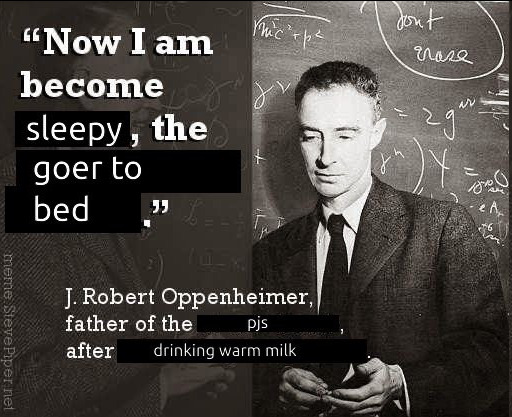
70 notes
·
View notes
Text
His Lighthouse || Part 2
Fandom: Servamp Ship: KuroMahi (Fem Mahiru) Characters: Kuro, Mahiru
Summary: After Mahiru’s uncle goes missing, she searches London for him. She meets Kuro and she asks him to help her investigate the disappearance. (KuroMahi, Fem Mahiru)
Part 1 || (Part 2) || Part 3

“This is everything I’ve found in my uncle’s office. He has been recording the suspicious movements of the Noberu family. The last date of his report is the same night he went missing.” Mahiru told Kuro. After they finished eating breakfast, she took him to her uncle’s office. She had decided to trust him and asked him to help find her uncle. “If we follow this pattern, he likely disappeared while investigating this family! They must be connected. I’ve tried to continue his work but no one will speak with me.”
“The Noberu are a powerful family. Even if someone knew about their crimes, they wouldn’t want to speak out against them. It’s best to be cautious when inquiring about the family. Between their wealth and status, they’re dangerous.” Kuro’s words made her think of the man who chased them the previous night. She was certain that she would’ve been killed if Kuro hadn’t rescued her.
She had decided to search for her uncle alone because she didn’t want to endanger her friends. Mahiru glanced towards the photo of her mother and uncle. “My mother was a duchess but I know very little about high society. They seem like a complicated bunch with their fake smiles and secrets. It was naïve of me to investigate the family so openly, wasn’t it?”
“I only met you yesterday but you seem like the straightforward type.” Kuro spoke his thoughts out loud and he noticed the small frown that appeared on Mahiru’s lips. He added, “I don’t think that’s a bad thing. For a while, I worked with your uncle and he had a similar approach to you. People are more willing to speak with him than us.”
“I never imagined they would brush me off the way they did. It made me realize how sheltered I’ve been in my little lighthouse. I mainly speak with my friends and relatives through letters.” Her mother and uncle had raised her in the lighthouse and it held a lot of precious memories for Mahiru. At times, she wished that the lighthouse was closer to the city so she could visit her friends more often. Mahiru had many chances to leave but she decided to stay each time.
She focused on the investigation again and said, “You said you worked with my uncle. Was it for investigations similar to the Noberu family?”
“Not in a formal way. He needed something taken care of and he paid me to look into it.” Kuro’s explanation was vague and she could hear that there was more he didn’t tell her. She reasoned that he had his own reason for why he wanted to keep his work a secret. Her uncle also hid his investigation from their family for the sake of their safety.
“I’m sorry if that was a weird question to ask a man I only met recently. I was hoping that you’ll have experience with investigation and you could tell me the best place to search for clues.” Mahiru said. “You don’t have to tell me about your past work with my uncle unless you’re comfortable.”
“My clients would have my head if I tell you such sensitive information.” Kuro didn’t know how she would react if he told her that he was an assassin. She could lose her trust in him if she learned that the Noberu family had hired him to silence her. He hated being an assassin but it allowed him to provide for his family. He had seven younger siblings and they lived in poverty.
When the Noberu first approached him with the request to target a brunette noblewoman, he had refused. Kuro thought it was wrong to kill someone who was innocent. Yet, it was difficult to refuse a request from a powerful family who would target his siblings in retaliation. If he helped Mahiru, she would pay him and he could keep his siblings safe from the Noberu.
“Your uncle has been gone for a month without contacting you. You said that he would send you a letter once a week while he’s on his past investigations. How can you be certain that he’s still alive?” Kuro sat in a chair across from her and studied her expression. “I don’t want to ask this to be cruel but we should be realistic about this. I’ll help you finish your uncle’s investigation but I can’t promise we’ll find him alive.”
“He’s alive!” She yelled and she stared into his eyes. Her brown eyes were steady and they reflected the determination she felt. “My uncle left me this note. It said his co-workers would come to collect his files if something happens to him. Until they come with the news, I believe he’ll return home. Something is stopping him and I’ll be the one to save him.”
“You know him better than me so I’ll trust your opinion.” He agreed quicker than she expected. Her friend, Licht, would often tell her that it was difficult for her to gain the respect of the men in her field. Kuro was different from the others and Mahiru became curious about what kind of life he had. “You’ve managed to collect a surprising amount of information on Frankenstein Noberu.”
“I went to the library to gather these documents. It’s not as much as I wanted.” Mahiru said nonchalantly. Yet, Kuro thought she was intelligent and studious from the progress she made on her own. “This is all the scientific discoveries that they’ve made in the past three generations. They have been given numerous grants but that money shouldn’t be able to cover the cost of research and development.”
“I’ve never went to school so you’ll have to explain the math to me.” Kuro told her. He broke his gaze with her because most would judge him for being uneducated. His family couldn’t afford to send him to school and he needed to work at an early age to feed his family.
“They must be getting money from somewhere else and embezzling the money from their grants. There’s a chance they’re using cheap materials in their research as well.” Mahiru told him without a hint of condensation in her voice. “My uncle has been tracking their movements but he can’t go inside the house to see the details of their experiments.”
“He has the graveyard circled in his map. If that’s a place he had seen them visit frequently, it’s possible that they’re grave robbing to fund their experiments.” He suggested and she nodded in agreement. “Unfortunately, it’ll be impossible to catch them in the act. I doubt they would commit the crime themselves though. They will hire thieves to do the work for them.”
“The Noberu own a large estate but my uncle went through each building to locate the one they would use for experiments.” Mahiru spread out the map between them and pointed to the notes her uncle made on each building. “This one has a basement and it’s far from the main gate. This is the best place to have a secret lab. We should break in to see if they have keepsakes they stole from the dead.”
“Did your uncle draw a map to a secret passage we could use to sneak inside? Otherwise, we’ll be caught easily and arrested. They’re a powerful family and they can bribe the judge to have us locked away.” Kuro pointed out. The sadness in her eyes answered him even before she shook her head. He took the map and folded it before he placed it in his pocket. “I’ll try to find a way inside.”
“Are you planning to investigate that house on your own? My uncle did that and they likely have him captured somewhere in that building.” She jumped to her feet to stop him from leaving. “Thinking simply, we need to work together to find a safe way inside. I already have a plan.”
Mahiru returned to the desk to take out an invitation from the drawer. “I was speaking with others to find a way to enter the Noberu’s manor. They’re holding a masquerade ball and we can use it to sneak in. I still have a few of my mother’s ballgowns that I can wear to disguise myself. You can accompany me as my guard.”
“You’ve thought this out.” Kuro took the invitation from her and studied the font. He wondered whether she would’ve gone to the ball by herself if they hadn’t met. Then again, he already knew that she was recklessly brave. She had pulled them into the river to escape the gun. “I’ll go with you but I’ll drag you out of that house the moment it becomes dangerous. Your uncle made me promise to protect you.”
“I doubted he expected the situation to be this dangerous when he asked that of you.” She recalled the events of the previous night and hugged herself. “That man with the gun would’ve killed me. Do you think there’s a chance that he could find us after we fell into the river? It has been a day and he hasn’t come for us yet. But…”
“Are you scared?” He asked. She didn’t answer him but he knew anyone would be afraid in her situation. Mahiru lived alone in the lighthouse as well. Kuro didn’t understand why he felt a little protective when he saw her loneliness. “Do you want me to stay here in case he comes? I can protect you.”
His offer surprised her but her face quickly softened. “Thank you, Kuro.”

The couch was comfortable and warm compared to the hay cots Kuro usually used yet he couldn’t sleep. With his past, he had trouble relaxing in an unfamiliar place. He turned on his side and stared at the door. Mahiru had insisted he sleep in her uncle’s room but he thought it was better to stay in the living room. He could hear an intruder enter the lighthouse if he slept on the couch.
Footsteps caught his attention and he instinctively gripped the knife hidden under his pillow. Kuro realized that the sound came from the stairs and he knew that it was likely Mahiru. The scent of roses filled the room and he relaxed slightly. He didn’t want her to lecture him about sleeping on the couch so he closed his eyes and feigned sleep.
Mahiru’s footsteps stopped next to him and he didn’t know what she intended to do. He felt something warm draped over him and he guessed that it was a blanket. Her hand brushed over his cheek and his heart quickened for a few beats. He knew that the light touch was unintentional so he had to question why it had an effect on him. She whispered under her breath: “If you’re going to sleep here, you should cover yourself properly. You’ll catch a cold at this rate.”
She leaned away from him and left the room. Kuro waited until he heard the creak of the steel staircase before he opened his eyes. Before she disappeared up the staircase, he caught a glimpse of her lonely expression. Kuro had never met a woman like Mahiru before. She was brave and genuinely cared for her family. He sat up and patted the warm blanket that she had put over him.
Her footsteps continued far past the living quarters of the lighthouse and he wondered if she intended to go through the files on the Noberu again. He decided to go help her and he rolled off the couch. “You lectured me about sleeping properly but you’re the one who’s staying up late with troublesome work.”
As he climbed the staircase, he glanced out the window to the cliffside next to the lighthouse. Between the bright light of the lighthouse and the waves crashing against the cliff, he didn’t know how someone was able to have a peaceful sleep. He reached the office and he was confused to find the room empty. Kuro didn’t know where else Mahiru would go inside the tall building.
Her sad frown appeared in his mind. There would be a lot on her mind after the stressful events of the past week. As strong as Mahiru was, she was a normal woman. He debated whether he should speak with her or if it would be better to leave her alone. Kuro didn’t know her well and he had never comforted someone outside of his family.
Before he decided what to do, he found himself climbing the stairs. Kuro reached the top of the lighthouse and pushed open the trap door. A warm breeze hit him as he stepped out onto the balcony connected to the lantern room. The heat was likely created by the large lamp spinning slowly. He scanned the balcony for Mahiru and he spotted her sitting on the roof of the little house.
“How did you get up there?” Kuro wondered aloud and his voice drew Mahiru’s attention. She thought that he was sleeping on the couch. She carefully moved to the edge of the roof and looked down at him. The glow of the lamp illuminated his face and highlighted his strong features.
“The light will burn your eyes and turn you blind if you continue to stand there.” Mahiru warned and gave him a reassuring smile. She was bathed in both the light of the moon and the lighthouse and he thought she was surrounded by liquid fire for a moment. She didn’t seem to notice him staring because she casually pointed to a ladder. “You don’t have to worry about me falling and hurting myself. There’s a ladder on the south side of the lantern room.”
“Do you want to be alone?” He whispered the question but it tugged on Mahiru’s heart. Silently, she shook her head. Kuro had called her strong and she was worried that he would change his opinion if he learned that she was scared. He climbed the ladder she pointed to and walked across the flat roof to sit beside her.
He didn’t want to pressure her if she felt uncomfortable speaking with him so he stayed silent. Among the quiet, his beating heart sounded like thunder. They stared at the stars above them and he listened to her soft breathing. While they sat far above the world, the vast sky made him feel small. The view in front of them was stunning but his focus was on Mahiru.
She slowly moved to hug her legs against her chest and curl into a ball. He hadn’t realized how small she was until that moment. Mahiru turned away from the stars to face Kuro. “The previous lightkeepers installed the ladder to remove bird nests from the roof but I like to sit up here to watch the stars. My uncle would teach me about the different constellations. You might call me a silly girl but I also thought he was a superhero for knowing so much.”
“I used to read books to my siblings.” He said and she tilted her head slightly at his words. Kuro could feel her brown eyes on him. “In those stories, the heroes will always come home to their family. Heroes have a troublesome habit of waiting until the last moment to save the day in a big reveal. It makes for an interesting story but their family is left behind to worry. You should lecture your uncle about that when he comes back.”
“I will.” Mahiru nodded with a warm laugh. Her heart felt lighter after he spoke with her and she was glad that he offered to stay with her. She knew he only wanted to protect her but he had done so much more for her. “Will your siblings mind that I’m taking so much of your time?”
“They’re already grown with their own lives. Also, my work often keeps me away from home for long periods of time and they’re used to it. They trust me to return home.” Kuro took off his jacket and placed it around Mahiru’s shoulders. She wasn’t cold but she held the jacket around her. “I’ve stared at the stars all my life but I don’t know much about them. Can you tell me what you know?”
“Well, there’s the North Star. You can see it no matter where you are.” Mahiru told him and pointed to the sky. He squinted into the vast collections of stars and he struggled to see which one she pointed to. Kuro didn’t expect her to move closer to him until her arm brushed against his. She sat close to him so their eye line would be the same and she placed her finger beneath the star. “See it yet?”
“I think so,” He said. Kuro was certain that they were so close that their lips would brush together if he turned to face her. She learned away from him and he didn’t know if he felt disappointed or relieved. Mahiru didn’t seem to notice as she continued to name the constellations in the sky. She wore a smile that would light the night better than the lighthouse they sat on.
15 notes
·
View notes
Text
Rain Plays SWTOR: Macrobinoculars Solo (most of it) - Imperial Pt. 1
Buoyed by Viri's success soloing the Seeker Droid questline, I decided to tackle the Macrobinoculars. Please note: THE END OF THIS MISSION IS STILL NOT SOLOABLE. There is apparently one sequence in the final H4 where you need several people to click all the panels. However, the rest is soloable. If you want some challenging gameplay or something new to do in the game, there's still a lot to do here without tackling the final H4. Also note that even if you do not finish the final H4, as long as you do NOT abandon the quest, you can keep using your macrobinoculars. In fact, you can do that as soon as you pick them up in the beginning of the quest line. There are other quests and achievements you can do with the macrobinoculars, such as scanning all the MCR-99 droids on each planet, scanning the temples you can see from the Yavin 4 stronghold and doing GSI dailies on several worlds.
If you enjoy puzzles, you will love this questline. If not, there are thankfully several guides that can walk you through each puzzle. If you remember one thing, it's that everything can be a trap, you need to check the walls, ceilings and anything around for clues/clickables to proceed, and the solution that appears straightforward probably is not. Once again, I defer to Dulfy for walkthroughs and videos on how to beat the puzzles, and give you additional suggestions. This is Part I of the guide, and it is specific for Imperial-side players. Your first task with the macrobinoculars is to scan the Shroud's monitoring devices around the galaxy. It's far easier than the Dread Seeds search. If you've played the Ziost daily area, the Ossus daily area or some of the Onderon quests, you've already used macrobinoculars. If this is your first time with the macrobinoculars- right click to activate the binoculars (they are in your mission items tab. You can also drag them to a quickbar, which is a good idea to get to them quickly). Once you activate the binoculars, you can scroll around to survey the area. Targets that are scannable will light up yellow. Left click to zoom in and scan. Click again to zoom out. ESC to put away your binoculars.
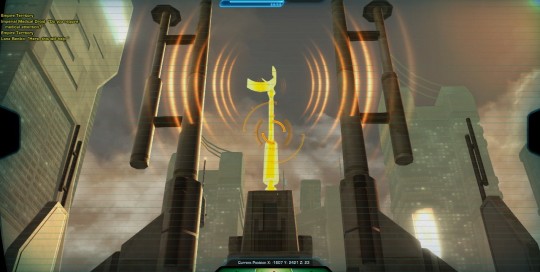
You’ll start by being asked to scan several locations marked on your map. Move your camera around until you see a yellow blinking item (it may or may not look like the example) and then zoom in to scan. Dromund Kaas - scanning - QT to Tempest. One objective is down at the Unfinished Colossus and the other is on one of the nearby lightning spires. - QT to the Spaceport. - QT to the Nexus Room cantina, and then walk over to the launchpad for the nearby taxi. You'll get a good view from there. Shroud of Ruin temple How to get there: Pick up the Shadow Spawn heroic and use the provided shuttle/QT. The temple you need is all the way in the back of that heroic area. There are a few jumps to get to the right level of the temple but they aren't too bad overall. There's no threat of death or even damage if you fall and have to try again.
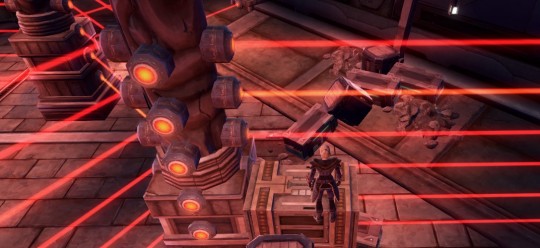
There are only two obstacles in this temple but the first can be frustrating. After you click a rock on the ceiling (mouse around to find it), some of the grids will periodically blink off and on (this is very slow- they don’t blink rapidly, if that is a concern. They go off, stay off for a few beats and then go back on). Make your way through the grid to get to the other side without touching the lasers. Touching the lasers is insta-death. Fortunately the respawn point/ medical droid is just upstairs from the grid so you don't have far to go if you get zapped. Tips: 1. Send your companion away. Put them on a crafting mission for ten minutes or so. They will not be able to follow you through the grid at your pace, so they'll just hit one of the lasers and die. 2. No fancy jumps, no rocket boost, no flair. Do NOT get too close to the lasers, and watch where you are running and jumping. 3. In some places, only one or two lines of the grid will flicker off. Be really careful walking through. 4. Once you finish the maze, you can turn it off completely by smashing the console you will see, but it’s really not necessary because you are almost done. It’s still cathartic to smash it.
The droid you have to face at the end of the hallway should be a snap. It's a garden variety NPC that doesn't seem much more complicated than the average silver, and he's on his own. You will then be sent off to scan targets on two more planets. Ambush Warning: After scanning targets on any of the planets from this point onward, you may be ambushed. It could be a droid and an enemy NPC that is found on that planet (rakghouls on Taris; a Wampa on Hoth). It could also be a gold-level droid, IR-77. I don't think it's a jump scare, but it's very sudden, so I'll mention it here.
Taris scanning:
- QT to 75th Legion Forward Camp. - QT to Crater Command Base. You can get to both of the targets in Olaris from here. - QT to Toxic Lake Garrison. This is the base you start at when you land on Taris so you shouldn't need to QT there, but it has a quick travel point in case you've done the others first. Tatooine scanning: A few of the target points are challenging to get to for Imperial players. - Mos Ila, relatively close to the taxi. There's a QT point there if you need it. - QT to Outpost Varath or Outpost Rennar, it's about halfway between the two, near the area with the Tusken Raiders and Mandalorian corpses. - QT to Mos Anek. Very close to the Lady of Pain area from the Bounty Hunter's class story. - QT to Outpost Zaroche. Unfortunately, the next target is in the Outlaw's Den. There's no way to see it from outside this area. I've read more than once that if you are on the PvE server, nobody can hurt you in the Outlaw's Den. Your companion will go away, but there's apparently no PvP. Still, I have had no way to confirm this firsthand, so I'd get in and out. - From there, continue through the Outlaw's Den to the north side and follow the road (filled with hostile NPCs unfortunately) to the mining company for the northernmost target. - QT to Ridgeside Sentry Post. You have a ways to go from here, but it's the closest Imperial travel point. Take the righthand road north at the fork. The lefthand side is more straightforward but goes through an area with a lot of Twin Suns enemy NPCs. The target is under the rock bridge near the Twin Suns. Quesh scanning: Quesh is small enough that you don't have to travel long to get just about anywhere, but here are the QT points in case you need them. - QT to Imperial Garrison OR Imperial Outpost. The target is about halfway between them in an area where a lot of the Imperial Quesh quests happen. - QT to Imperial Outpost. - From the second target, you will see a very small dotted line path that goes through a power plant. The first section has Republic hostile NPCs but the second section is friendly. This will take you to the other side of the map to get the third target.

Scratch the Surface - Quesh How to get there: As Dulfy notes, the map may be bugged. This is the map I got. As you see, the entrance is indicated all the way over on the far right. It's not there. QT back to the Imperial Garrison. The map should change. You need to climb the hill just outside the Garrison and follow the narrow, maze-like path through the stone walls to reach the instanced area.
Wrong map:
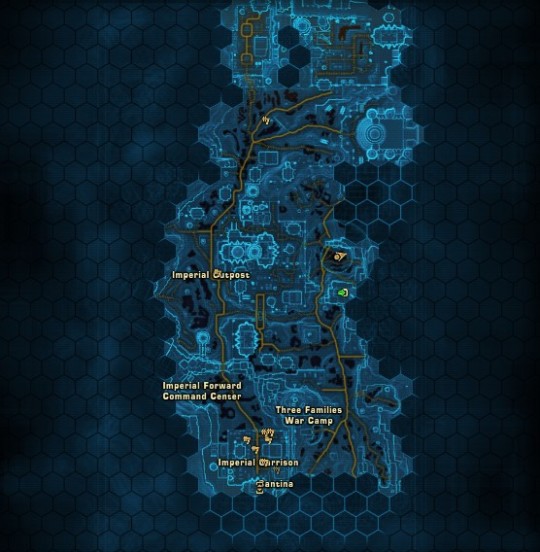
Here is the CORRECT map.
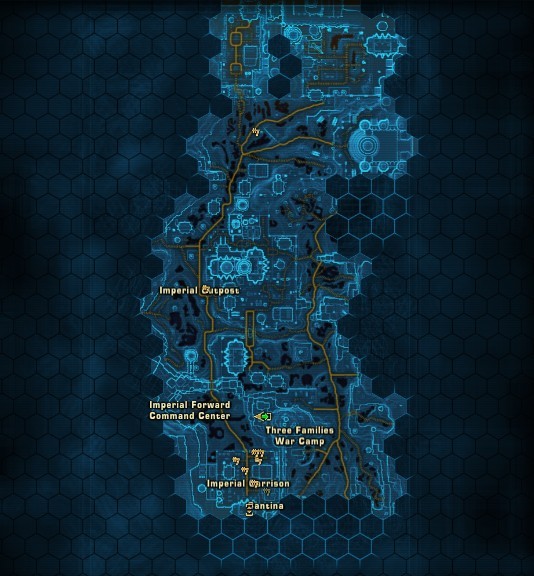
Once inside, remember everything is a trap and the solution usually is not straight combat or avoidance. There's always something clickable around that will help you get past each obstacle.
To throw the fruit at the Lurker, click on the gate panel. The key to getting past this electrified floor is to hit the panels on the ceiling that light up as clickables. After that, the floor will still electrify, but in a very predictable order.
This is the only panel on the first section of grid that will not be electrified. It's easy to spot because of the debris on it. Follow the electricity's pattern so you know when it's clear to run. Once you're there, mouse around the ceiling again for the second clickable panel.
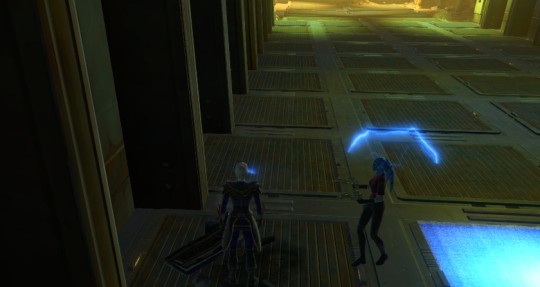
This is the panel on the second section of the grid that is not electrified. Again, it's easy to spot because there's stuff on it. After this, you will need to follow the pattern of the electricity and make a break for the hallway.
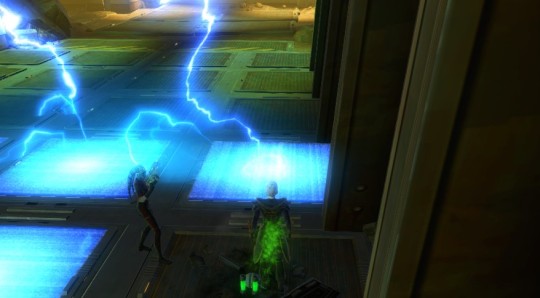
You need to shut down the grid to proceed. However, if you step on the platform, you'll get shocked. Walk around the room to the back, where you will see a way to get under the panel. DO NOT WALK ON IT YET. Mouse around and you will find there's a panel that is clickable. Clicking on it will cut the electricity on the floor, allow you to walk in and shut down the second panel. Now you can go on the platform and shut down the grid. Pictured is STEP THREE. Do not go on this platform until you cut the power from underneath!
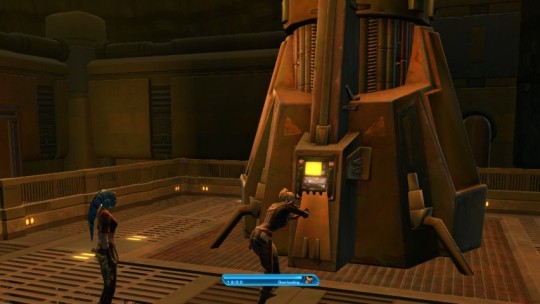
Then, it’s off for more scanning. Corellia - The first two are close to the spaceport and Incorporation Islands QT point. - QT to Axial Park South. - QT to Imperial Central Command (two are here) Hoth - Very close to Dorn Outpost, where you start out on Hoth. - QT to Thesh Outpost. - QT to Imperial Garrison. - QT to Jagged Hills Imperial Garrison, which is the northernmost Imperial travel point. From there, go left until you get to the Drift Hills Republic base and then north along the path. It's close to Republic Aurek Base. - From the point above, go to the right on the marked path. You want to be heading toward Outpost Cresh. When the road has a fork on the righthand side, take that, going south. The point you're looking for is under one of the bridges.


- QT to Frostwake Outpost and then go to the Starship Graveyard. - QT to Leth Outpost. It's very close to the base. Belsavis - QT to Imperial Frontline Camp. - QT to one of the outposts close to the Rakatan Transport network (Frontline Camp and Imperial Deep Launchpoint both work). Take the Rakatan Transport to the Imperial Power Center Transport. - From the point above, after you scan, go right back to the Rakatan Transporter. Take it to the Lower Prison Magma Transport stop. Follow the circular path to the Tomb and then find your path to the target from there. You want to do the Lower Prison Magma Transport target scan last because it will place you in just the right area for the next part of the questline.
10 notes
·
View notes
Text
This is the first time I wrote a really long post about DuckTales
So, to pass the time until DuckTales come back in April I decided to map out the seasons that’s already been aired to find out who and what the season’s about, how many episodes a particular storyline or arc is given, and maybe make a few theories about season 3.
Before I start, season finales are not included in the count up because I think they just include everything that we learned throughout the season.
Season 1 is Dewey’s season. His main arc is about finding out what happened to his mom, but his personal arc is learning that he doesn’t have to always have do things on his own to impress anyone and that it’s okay to rely on others for help.
Now on to how many episodes that focused on him this season:
Escape to/from Atlantis! (Woo-oo! part 1)
The Great Dime Chase!
The Infernal Internship of Mark Beaks!
The Spear of Selene!
The Missing Links of Moorshire!
Day of the Only Child!
Sky Pirates...In the Sky!
The Secret(s) of Castle McDuck!
Total: 8 episodes
I really debated on having some episodes included in the list because if you think about only four episodes focused on his Della investigation and some episodes didn’t focus entirely on him but still had a major part. The Last Crash of the Sunchaser is not on here or any of the following lists because I think the focus was evenly divided among the characters. Well I guess you could make the argument that it focused on Dewey and Scrooge since they seemed to be the driving forces in that episode. But I don’t count it because it’s way too sad and I’m not putting myself through that. But anyway, I got to thinking “No it’s Dewey’s season. His episodes don’t have to be exclusively tied to that arc.” Besides, his other episodes have moments of what he really thinks of himself and how he wants others to see him. Plus, we got Dewey Dew-Night!
Wow that got long but let’s move on to the next season!
Season 2 is Louie’s season. His main arc is about him trying to find a specific in his family and how to fit in it with what he knows how to do best. His personal arc is about him learning to be more humble and more appreciative of what he has.
Episodes that focused on him:
The Most Dangerous Game...Night!
Storkules in Duckburg!
The Outlaw Scrooge McDuck!
Happy Birthday, Doofus Drake!
Timephoon!
GlomTales!
The Richest Duck in the World!
Total: 7 episodes
I honestly had no problem trying to decipher which were Louie’s episodes. I didn’t think to include The Ballad of Duke Baloney because it was mainly about Glomgold.
Season 1 also had another character that it focused on and that was Scrooge. His arc was about reconnecting and bonding with his family after being separated from them for so long.
Woo-oo!
The Impossible Summit of Mt. Neverrest!
The Missing Links of Moorshire!
The Golden Lagoon of White Agony Plains!
From the Confidential Case Files of Agent 22!
The Secret(s) of Castle McDuck!
Total: 6 episodes
I counted these episodes even though some of them was also about other characters because they were about Scrooge’s history and relationships with these people.
Season 2 was also Della’s season since this was the first time we fully got to know her. Her arc was about reuniting with her family and learning to adapt to new situations.
What Ever Happened To Della Duck?!
The Golden Spear!
Nothing Can Stop Della Duck!
Raiders of the Doomsday Vault!
The Golden Armory of Cornelius Coot!
Timephoon!
The Richest Duck in the World!
Total: 7 episodes
I think Della’s episodes were pretty much straightforward. In episodes where she’s focused or involved in a B story where she has a role that has some significance, Della either bonds with her kids, makes connections with new people and/or learns a lesson while also learning something new about her in the process.
In season 1, Magica is the main villain. Her arc is about stealing Scrooge’s Number One Dime to free herself from it, then to seek revenge on Scrooge and his family.
Terror of the Terra-firmians!
Jaw$!
The Other Bin of Scrooge McDuck!
Total: 3 episodes
I decided not to include The Beagle Birthday Massacre because the episode was mainly about Lena and Webby, and Magica doesn’t appear until the very end. Also, we don’t get mention of any plans from her until Terror of the Terra-firmians.
In season 2, Lunaris is the main villain. His arc is about befriending Della to gain access to her rocket ship manual for him to use to invade Earth.
What Ever Happened To Della Duck?!
The Golden Spear!
What Ever Happened to Donald Duck?!
Total: 3 episodes
Nothing Can Stop Della Duck is not on the list even though Lunaris appears at the end is because that was primarily a Della episode. Same reason why The Richest Duck in the World is not on here. Lunaris may not have actually appeared but Penumbra did send out a warning about Lunaris’ invasion. However, that happened at the very end of the episode.
From doing this, we can tell that a season is usually about one of the kids, an adult relative of theirs, and their respective season’s villain.
So for season 3, we already know it’s Huey’s season and that investigating F.O.W.L. is one of his arcs.
I gonna take a guess as to what his other arc could be about but it could be that Huey learns that some things can be out of your control and that you need to make the best out of the situation. I’m basing this on some moments in the show of where something didn’t make sense, Huey would get angry, upset, or afraid.
Donald could be the adult relative that the season is also. Plus, we been told that Donald does have a mini arc coming up.
F.O.W.L. is the villain of season 3. Either just the faction or the vultures themselves doesn’t matter.
Well that’s it for my train of thought. I hope y’all enjoyed get a look into my head about these seasons!
#ducktales#ducktales 2017#huey dewey and louie#scrooge mcduck#della duck#donald duck#magica de spell#general lunaris#f.o.w.l.
63 notes
·
View notes
Text
WW2GI and the saving private ryan TC for duke nukem 3D: a level-by-level breakdown
EPISODE 1: D-DAY
the first half of the game starts off with a bang as you're dropped right into it with the omaha beach landings; from there you'll go on through the hedgerows and villages of normandy, killing nazis left and right and dying... again... and again... and again. according to the credits, we can thank tuoma "tuco" korva and lado "icebreaker" crnologar for the level design, but i've no way of telling you who did which.
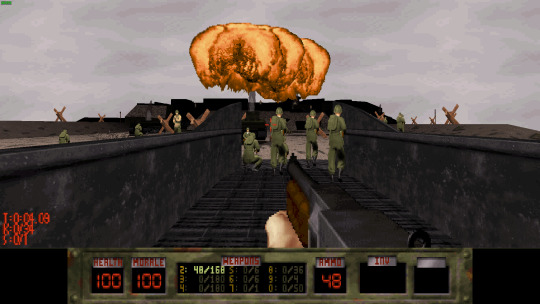
E1L1: d-day what's more iconic in united states military history during WW2 than omaha beach? this recreation of the bloody battle might not be as lethal as the real thing, but it sure is nearly as nightmarish. the game throws you in deep real fast and you're forced to learn, through trial and error, the basics of the game, all the while random explosions and bullets out of nowhere will cut your gameplay short. you'd think they'd at least give us some basic training... even medal of honor frontline was more forgiving.
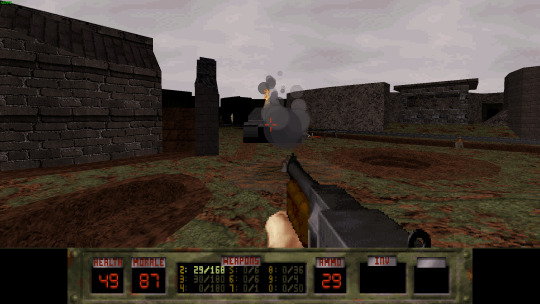
E1L2: atlantic wall omaha beach, part 2. you're alone for this one, you and several dozen enemy troops as you work your way through a complex of shattered bunkers and rail lines. not much sense to the layout on this one, though cool carnage as a row of parked trucks are annihilated in an artillery explosion -- along with all the nazi goons hiding behind them.

E1L3: defend you meet up with some friendlies just in time for a panicked radio message -- a squad is pinned down under enemy fire and need help. working your way through a flooded village and a forest infested with nazis, you eventually come upon the squad, hiding in some foxholes as a couple dozen enemy mysteriously teleport in by a hedgerow on the far end of the field. aside from some extra ammo, you also get access to an artillery strike via radio and a mortar launcher. hold out long enough and a gate will open with reinforcements behind, and the exit beyond.
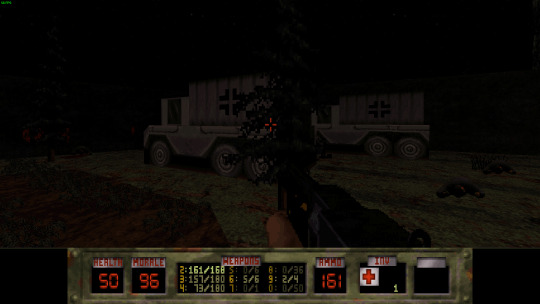
E1L4: hunt for the 88s jesus christ. if you managed to get through the d-day map without getting too frustrated you may wind up throwing in the towel on this one, an extremely dark night mission in the woods where the enemy can see you but you can't see them, and they always have insanely good aim. the one thing it has going for it is a pretty cool scripted sequence where you and a squad of guys traverse a bit of forest, exchanging some bad banter -- very cool for the build engine! and then they all die in an ambush, leaving you to play audie murphy -- again.

E1L5: finding private mccurkee first of all, lol. second of all, this mission is actually almost fun. a ruined little town teeming with enemy, you'll have an opportunity to use a rifle to pop enemies from a distance, which will be useful as there's plenty of snipers. a mortar team will make your life hell near the end. it's fun working your way through the ruined buildings and finding ways to climb up into otherwise inaccessible rooms.
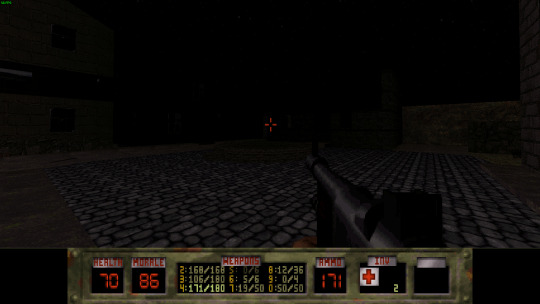
E1L6: saving private mccurkee did you like e1l5? how would you like to do it again, only this time in reverse, in the dark, and with an NPC in tow that you have to babysit -- assuming he doesn't get his dumb ass stuck in the foxhole right at the beginning of the level and then you don't notice he's done it so you save your game like a dumbass and now you have to noclip through the gate at the end because the idiot doesn't know how to climb?
yeah. i didn't like e1l6.
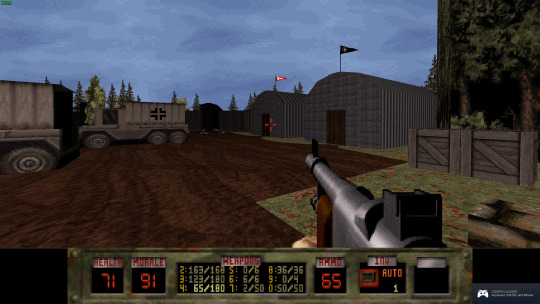
E1L7: mop up the final mission of the d-day episode is a mercifully daytime shootout across a semi-detatched military complex in which you shoot a bunch of nazis, blow up some tanks, dodge some artillery fire and, in the end, lay waste to a small, fenced-in compound guarded by SS, who distinguish themselves from regular grunts by their distinctive black uniforms and red nazi armbands. just hanging around them lowers your morale; ignoring the fact that the morale system makes no sense, this does amusingly give rise to the idea that the SS are so evil that they can sap you on a psychic level.
i mean, that's true of nazis today.
final thoughts: not a good first half. maybe three or four of the levels are salvageable; the rest are unmitigated shit, especially e1l4. while this is very likely the first-ever WW2 FPS to feature the omaha beach landings and the normandy invasion at large, it's a novelty at best, an exercise in frustration that shows the limits both of the engine and the designers' talents.
EPISODE 2: FRANCE
not sure what exactly distinguishes this episode from the previous, except that it's perhaps a continuation of the battle of normandy? who knows. regardless, it's another 7 levels of this shit, because they couldn't see what they did in episode 1 and think "we've done enough damage."
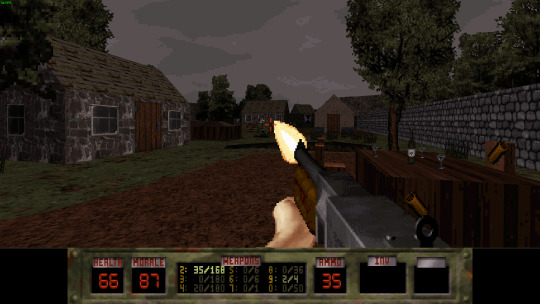
E2L1: hell from above a much more sensible first level, this is essentially a sweep-and-clear mission as you work your way (alone, of course) through a cute little village along a river. lots of wide open space means little cover for you, but it also makes combat a bit of a turkey shoot (especially with auto-aim on.) oddly you get tons of MP40 ammo -- even maxing it out -- before you ever actually get the MP40.
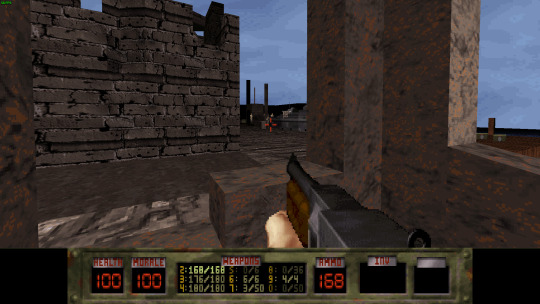
E2L2: seaside sweep a quick jaunt through a seaport. lots of nazis, and lots of BAR ammo to perforate them with. would actually be a decent level if not for an issue i ran into -- i don't know if it's endemic to the game or if it's a bug introduced by eduke32 -- that placed two very large wall texture sprites in the map that blocked my view of the final building, forcing me to god mode just to be able to approach the place.
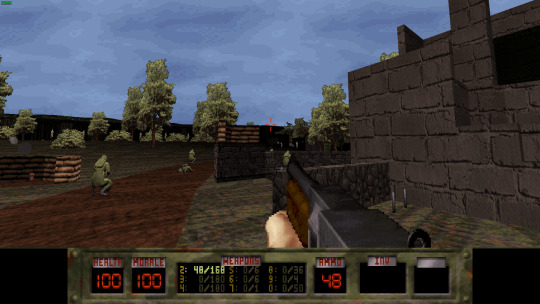
E2L3: under fire similar to "defend" from the first episode, the first half of this mission involves you facing off against endlessly respawning waves of germans until such time that you're called to retreat through the village, which is swarming with germans. clear your way through it and you're treated to a grisly scene of SS troops forming a firing squad to execute captured allied prisoners. definitely feels like a precursor to the early call of duty levels. it's not *too* bad a level i guess.
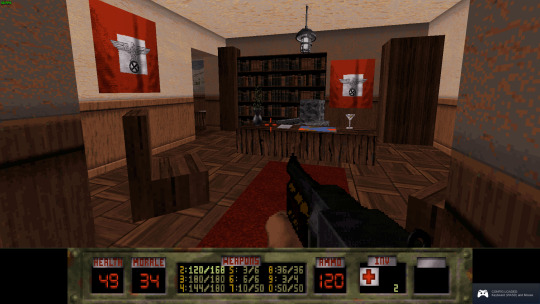
E2L4: paperwork it's time to attack an SS-occupied chateau in this quick little mission. it starts off surprisingly easy with a short, linear path that takes you through some countryside. a heavily fortified bridge serves as the main defense of the chateau and every window bristles with guns. get inside the chateau walls and it's wall-to-wall SS, draining your morale with every burst of their MP40s and having the infuriating tendency to have your shots (especially your BAR) go right through them.

E2L5: railroad typhoon you've been tasked with rescuing a bunch of captured allied troops who've been put on a train, which means storming a trainyard. it's mostly wide open spaces here, though there is a cool part in a connecting tunnel where you're checking train cars. the trainyard itself is comparatively vast, and enemy fire comes from all directions. relatively fun map.
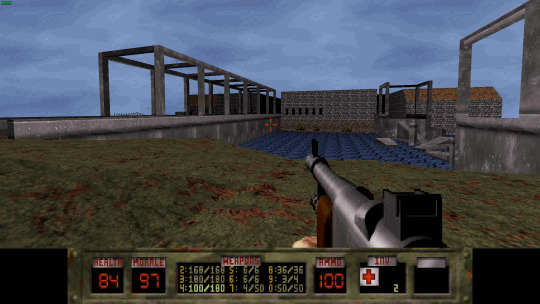
E2L6: a game of bridge like the name suggests, the key feature of this level is a bridge, currently occupied by a tank and a large contingent of nazis. to get there you'll have to fight your way through the town; across the river are rows of windows from which the enemy shoots at you (a common feature in this episode that i'm starting to suspect may be a favorite feature of one of the mappers.)
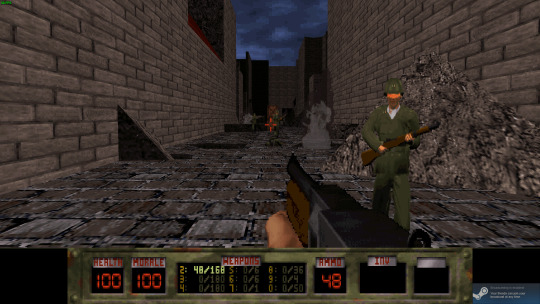
E2L7: urban rush the finale of WW2GI involves fighting your way through a massive urban area to rescue a captured general. this is probably the largest level in the episode; with an enemy around every corner. while it's otherwise an interesting, intense level (a small legion of semi-invincible SS notwithstanding) there's a frustrating bit where you must go through a no-man's-land of sorts that's constantly being bombarded by artillery.
final thoughts: a significantly better second half, but the problem is, that's not saying much. it still suffers from issues endemic to the game, like the insane reaction times of the enemy, the massive damage they do to you, and so on. however, the gameplay is much more straightforward for the most part, with no NPCs to babysit, no weird trial-and-error "wtf do i do next" issues, just pure nazi slaughter. now if only the game didn't suck.
PLATOON LEADER
platoon leader is a free expansion for WW2GI that adds three more levels to the game and several additional features. two of these, inexplicably, are set during the vietnam war, a throwback to TNT team's earlier outing NAM (which itself was a sequel to their earlier free mod for duke nukem 3D 'platoon,' based on the movie of the same name.) the remaining level, however, is set in the pacific theater of world war 2. the result is that the armory is a mix of WW2 and vietnam war-era weaponry, with the level design such that you won't receive weapons that don't belong in the era you're playing. speaking of level design, no clue who did this one, but i want to punch them.
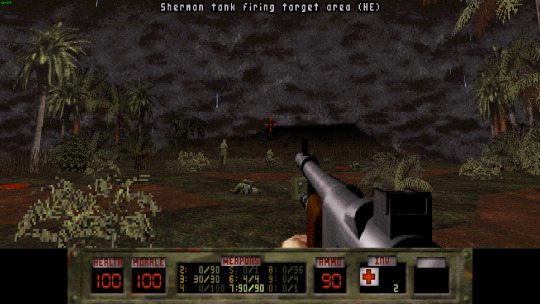
PLT_E1L1: hill 41 eeeuuugh. you start at the base of a hill. while you have a radio that can call in both a tank assault as well as an air strike, your main strategy is going to be charging up a hill swarming with IJA troops. while the hill is actually rather realistically constructed, with varying slopes and flat planes, this is about the only interesting facet of the level design as the entire hill is covered in invisible land mines and enemy shooting at you. making matters worse is that the game seemingly arbitrarily will declare the mission a failure and cover the screen with a failure notice, forcing you to restart. i even god-moded my way up to the top, killed everything i could, blew up the tunnel entrance, and still failed. this level sucks.
SAVING PRIVATE RYAN TC* FOR DUKE NUKEM 3D
"saving private ryan" is a landmark war film that changed how war movies were made and inflamed the imaginations of game designers everywhere. imagine storming omaha beach from the comfort of your own home; imagine fighting through the hedgerows. while the commercial game "WW2GI" was the very first world war II-themed FPS that wasn't wolfenstein with its abstract mazes and mad science, "saving private ryan TC," released a few months after WW2GI (and using some stolen assets from it), was an attempt by a small group of duke 3d fans to recreate their favorite war movie. in this mod for duke nukem 3D are five levels, each one representing a key scene from the film. an archived version of the mod's website lists two people as level designers: jeff (using the name eXtreme-Rush) and jody (using the name kissle.) i couldn't tell you who did which maps, not that it terribly matters.
* note: TC stands for total conversion, an older term for what we'd now simply call a mod
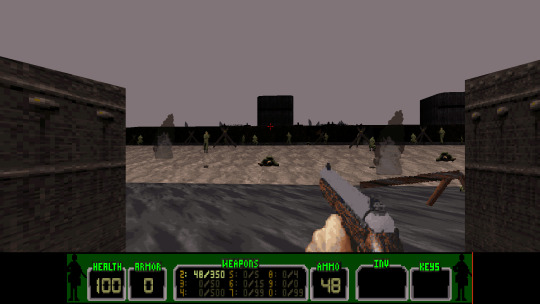
SPRL1: ohmaha beach yes, that's how it's spelled. basically a worse version of ww2gi's d-day map, it can be done in a matter of seconds. once you blow the shingle and get up onto the ridge it's just nazi city in the trenches beyond, and ammo is scarce -- you're better off just running towards the crater with the movie poster in it.
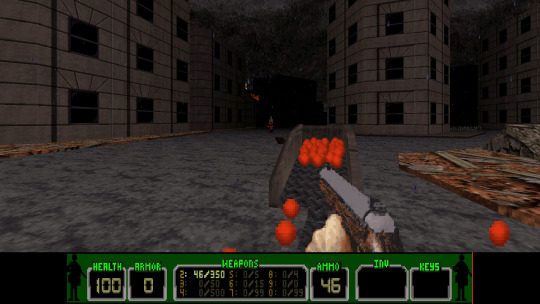
SPRL2: vierville very short little jaunt through a war-torn village, with a squad of useless soldiers following you. the ruined applecart from the movie is here, as is the half-blown out house; a lone enemy up in a tower is easily dispatched, but figuring out how to get past the invisible wall blocking your further progress is tougher.

SPRL3: bunker another short level, a charge up a hill with the enemy already firing at you. the bunker itself with the radar is cool-looking, at least.
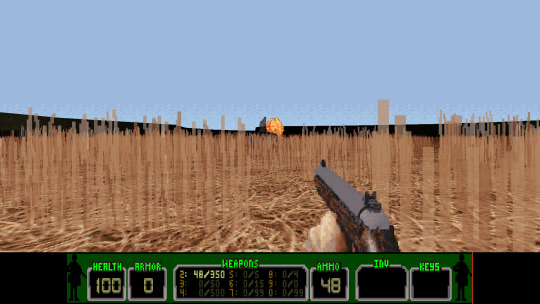
SPRL4: the fields basically "bunker" but with tall, semi-transparent grass sprites everywhere. kill all the nazis and then go talk to the US soldiers hiding near the burning halftrack, and you're on to the finale.
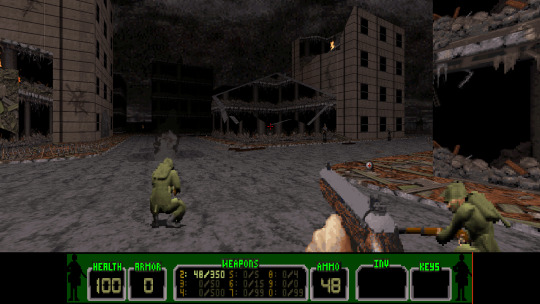
SPRL5: last battle probably the closest this thing gets to a real level, and it sucks ass. you'll not hurt for ammo, and health items actually show up here, but the place is teeming with enemy and cover is light. get across the bridge and you're done.
final thoughts: whoof. while it's true they recreated the setpieces, it comes at the expense of gameplay. the levels are, in a word, ugly and simple, with little in the way of anything distinctive. the whole thing can be gotten through in about 10-15 minutes; wouldn't it have been more fun to simply mix the movie's story beats into a broader game that more closely resembles WW2GI? sometimes i wonder what happened to the mod team; it's clear they were young when they made this (weren't we all, back then...) i guess in the end i admire what they were trying to do, and i appreciate that they were young and didn't really think this through. but it just doesn't work.
#ww2 fps#ww2#saving private ryan#ww2gi#duke nukem 3d#game modding#shovelware#classic gaming#classic fps
32 notes
·
View notes
Text
The 3 Act, 9 Block, 27 Chapter Plotting Method
There are countless ways to structure your story. There’s the general plot structure (exposition, rising action, etc.), the hero’s journey, and three-act structures—but do you really know how to put together a plot and put it into action?
The 3 Act, 9 Block, 27 Chapter plotting method is an excellent resource for both plot and pacing, and I use it for almost all of my projects. I’ll review it here and give you an idea of what it is, when to use it, and how to put it into action.
What is the 3 Act, 9 Block, 27 Chapter Method?
The 3 Act, 9 Block, 27 Chapter outline method is exactly what it sounds like: there are three acts, which are divided into nine blocks, which are then divided into twenty-seven chapters. Be Your Own Mentor has an excellent page describing each block and its subdivisions here. I strongly recommend checking out this page, as it explains each aspect of this plotting method in detail.
However, this outlining method does more than just suggest where to put plot-points—it’s also a guide for pacing. Each block should be roughly the same length, which helps prevent your story from getting a sagging middle. This relatively uniform length also allows you to set word-count goals for each section, particularly if you’re aiming for a specific word-count in a project.
For example, in an 18,000-word novella, each act (which I split up evenly—some people prefer to have the second act span from the first plot twist to the second plot twist) should be roughly 6,000 words. With three blocks in each act, this means that each block should be roughly 2,000 words. This allows me to keep an eye on how much I’ve written and adjust my scenes/pacing accordingly.
When to Use the 3 Act, 9 Block, 27 Chapter Method
First of all, this is most useful when you need to fast-draft a clean, tight, and effective story. I use it for all of my ghostwriting work, as it is simple, straightforward, and allows me to both discover and understand my story (and what I’ll need to pull it off) while outlining.
That’s not to say that this method is ill-suited to other projects. It’s actually quite versatile (I’ve gone so far as to merge it with the formulaic structure of mystery novels) and simple to use, once you understand it. Even if you’re a discovery writer, it can be really helpful to keep an eye on this chart and make sure you’re hitting all the beats you need to, and that you’re moving your story forward instead of stalling.
That said, it can be less useful for short fiction. Short stories tend to follow a different structure altogether, with many focusing on a specific scene or mood-related to their premise (although I have, on occasion, seen short stories with full plots), so having a beat-sheet or three-act outline won’t necessarily work for you. Now, you can absolutely take parts of the 3 Act, 9 Block, 27 Chapter outline and focus on, say, only Act II or Block 4 for the duration of the short story—because, as I said before, this is a really versatile tool. Play around with it and see what works for you!
Basically: if you need to know the beginning, middle, and end of your story; need a simple beat-sheet for your project; or even just want to familiarize yourself with the generalized structure of a long-form story, this is a great resource.
Key Terms
While BYOM does an excellent job explaining the gist of the 3 Act, 9 Block, 27 Chapter outline, there are a few things that may still be confusing if you’re not 100% familiar with all the fancy plot-terms involved. So, before I dive into how to use the 3 Act, 9 Block, 27 Chapter plot structure, I’m going to clarify a few terms that may cause confusion.
Plot Point - You’ve probably heard of them, but I promise they don’t have to be as dramatic as popular media would have you believe. There’s no need for a surprise! The character was dead all along! if it won’t suit your story. Still, plot twists make for a good story. They keep things fresh and interesting. And, this is important, they don’t have to come out of left field. For example, in romance stories, a plot twist could be something like a plot point the main character forgot about coming back to influence their story, or a revelation of an important character’s backstory, secrets, or other important traits. What I’m trying to say is that these should be Big Moments of your story, but they don’t need to be world-shattering. They should feel natural and rewarding to your story’s premise. These should occur at roughly the 25% and 75% mark of your story.
Midpoint - Strictly speaking, this is the middle of the story. It marks a change in your protagonist: where they were reactive in the first half, they become proactive here. They’ve learned about the new world/situation they’re in, and it’s time for their character arc to impact their choices going forward.
Reversal - Here, both the readers and the protagonist see something in a whole new light. This may be caused by a change in circumstances (in a thriller, for example, this may be a trusted ally betraying the protagonist) or by the protagonist’s new perspective shifting the way both they and the readers see the events of the story. To put it simply, this is where something known changes form. A friend turned foe, a job gone wrong, and even a sudden realization that demands the protagonist’s attention all work. This should occur after the midpoint, where the protagonist has changed.
Reaction - You’ll notice that this appears twice in the 3 Act, 9 Block, 27 Chapter structure, and the ambiguous nature of the term may be confusing for some folks. The Reaction is not so much your protagonist’s response to everything that’s happened thus far so much as it’s their reaction to the plot point that occurred immediately before it. How does the protagonist react to the inciting incident (and its immediate consequences…)? How does the Reversal affect their behavior? These are the questions you’re answering at this point in the story.
Action - While the first half of the structure is mostly reactionary, there’s no getting around the fact that a reactionary plot can be boring, even annoying. This is where you show how your protagonist acts under pressure; something Big has just happened to them, and now they need to decide how to proceed with their life. Do they run, or do they charge into conflict? This defines your protagonist at the early points of their arc and serves to contrast their eventual development in Trials and Dedication.
How to Use the 3 Act, 9 Block, 27 Chapter Method
If you haven’t already, I recommend taking a look at BYOM’s break-down of each block. It’s a very useful guide and will give you an idea of how each point ties into the next.
Ready? When outlining, I keep a “skeleton outline” on hand that looks like this:
This “skeleton” allows me to keep track of everything while I put together a plot in another document that will get far messier and harder to keep track of than the clean, easy-to-read skeleton. In the functional outline, I usually mark my actual outlines with the block numbers and goals, as seen in the second image, but that’s largely due to how I structure my Scrivener document after I’ve completed the outline.
After I’ve set up my outline and have my “skeleton outline” (combined with any genre formulas, as with mystery) ready to go, I begin writing the plot. This usually takes me 1-2 days, depending on my current work-load and productivity levels.
As you can see, I’ve blended a few points together (such as in Block 4, where there’s a lot of overlap in the block’s structure) and added several notes to myself while filling out what happens at each point. You’ll also notice that I write more the further I get through the outline—this is partially because I’m getting familiar with the story, and thus have more to say, and partly because there’s more to keep track of as I get further through the plot. (Including b-plots, which I also make note of in this outline.)
The goal here isn’t to map out everything that happens so much as it is to give me an idea of what I want to be doing in each part of my project. At the beginning, I need to focus on the romance, but in Act II I’ll pay more attention to the b-plot. I often jump around on the outline as I figure things out (such as plot twists, as knowing what these are in advance makes it easier to build them up) and add notes regarding characters I need to create, places I need to have descriptions for, and other project-relevant details.
From there, I set up my Scrivener document. As you can see, I combine and separate each aspect of the blocks as I see fit; the ‘27 Chapters’ is more of a guideline than anything else. When working on a project with chapters, I’ll label each scene with the chapter it will go into, but I don’t sort them into chapters until I’m done writing.
You’ll also see that I write a schedule for myself based on a) how much I need to write, b) when I need it done by, and c) how much I’m able to take on. This is my job, so my schedule is tighter than it would be for someone doing this in their spare time. And, while having a schedule is by no means required, it helps when it comes to managing your project and working to its end. I use highlights, labels, and status markers to keep track of my work and let myself know where I am and where I need to be.
Outlining is a really personal thing, as you’re not just putting together the structure for your story—you’re putting it together in a way that makes sense to you. With the exception of clients who request outlines, no one except for me will ever see this outline. Ultimately, the outline is yours, and yours alone.
Find my blog useful? Leave a comment or check out my Patreon for early-access and extra content! Thanks for reading, and happy writing!
#Plot#Outlines#Writing Advice#hgwhhsj i forgot i’d scheduled tis to post here from my website#but it’s here!
19 notes
·
View notes
Text
Rule of Three: Analyzing the Story Structure of Kingdom Hearts
Kingdom Hearts is kind of obsessed with putting things in groups of threes.
We have all our character trios…
For most of the series you could only have a maximum of three characters in your party….
The 99 Dalmatian Puppies were hidden 3 to a chest throughout KH1…
The first 3 Disney worlds of a “main” Kingdom Hearts game are typically grouped on the World Map into clusters of 3:
KH1: Wonderland, Olympus Coliseum, Deep Jungle
KH2: Land of Dragons, Beast’s Castle, Olympus Coliseum
BBS: Enchanted Dominion, Castle of Dreams, Dwarf Woodlands
DDD: La Cite Des Cloches, The Grid, Prankster’s Paradise
KH3: Olympus, Toy Box, Kingdom of Corona
There 3 Key Cards needed to advance the story for each Disney world in Chain of Memories….
There are only 3 Disney worlds in Re:coded….
You get the idea.
There is also Yen Sid’s book in KHII that when you read is divided into three sections:
“The Beginning”
“The Interlude”
“The Future Story”
Thinking about Kingdom Hearts in the context of storytelling frameworks, it would make sense to conclude that the overarching narrative of the series would fall into a three act structure. A beginning, a middle, and an end.
With the series now being divided between the Dark Seeker Saga and the Lost Masters Saga (as fandom has dubbed it in lieu of an official name), the logical conclusion would be that the story of Kingdom Hearts will ultimately be divided into three sagas. The Dark Seeker Saga, the Lost Masters Saga, and one more after that.
Right?
Not necessarily.
From what has been established so far, the Master of Masters is the biggest antagonist in the setting. Regardless of his still-unclear motives, his actions in the age of fairy tales are what set the events of the entire series in motion. Not only that, but the KH3 Secret Reports and the DLC trailers reveal that all of Xehanort’s actions were part of his design, actively encouraging Xehanort’s ambitions with Luxu as a devil on Master Xehanort’s shoulder.
With the KH3 secret ending and Re:Mind trailers confirming his return in the present day, he is being thoroughly established as the next major antagonist of the series. With Xehanort out of the way, the Master of Masters has returned to the stage to pursue his agenda in person.
With the scope of how the Master of Masters has affected the plot of the series, I don’t see how Nomura would be able to top that with a third major antagonist. Revealing that there was an even bigger threat that had influenced the Master’s actions in some way would feel a bit repetitive after the reveal that he had orchestrated Xehanort’s rise to power all along. But a new villain with no connection to either the Master or Xehanort would honestly feel like a step down at this point.
And what better choice for the final antagonist of the series than the man whose manipulations set the entire narrative in motion?
Then something occurred to me.
Someone pointed out on Twitter (I can’t remember who specifically) that the ending of KH3 marks the first time since the end of KH2 back in 2006 that the audience had a relatively blank slate as far as speculation about future titles was concerned. So I asked myself: Does the Dark Seeker Saga only take up one act of the series, or two?
Kingdom Hearts, Chain of Memories, and Kingdom Hearts II tell a complete story with a clear beginning, middle, and end. While there are hints at future mysteries, the future of the series was still a blank slate where the possibilities of what direction the story could go in next were endless. All of the games released from Birth by Sleep onward were building up to either rescuing characters who were suffering because of Master Xehanort’s actions, or building up to the final conflict with the aging Keyblade Master. But at the end of KH2, there was no looming threat or huge mystery to solve, and the game’s epilogue ended with an upbeat “the adventure continues” tone.
Not to mention, the series’ infamous complexity really only started coming into play from 2009 onwards. New mysteries are set up and new characters are introduced. When all we had was KH1, COM, and KH2, the lore was honestly pretty straightforward. It was the trio of Birth by Sleep, Days, and Re:coded, followed by Dream Drop Distance, that expanded the lore and the mythos of the series, as well as established the greater conflict with Xehanort. Which in a long form story is the exact kind of thing you would expect to happen when you start getting into the second act.
I think that if the overarching story of Kingdom Hearts is ultimately divided into three acts, then the first three games are Act I. They introduce audiences to the setting, the characters, and the major concepts of the mythos.
The rest of the Dark Seeker Saga is Act II. These games introduce new characters, new concepts, and expand on the franchise’s lore. They pull back the curtain on the previous arc and reveal that there was more going on behind the scenes that Sora was not aware of, setting up a new conflict to put an end to Xehanort’s ambitions permanently and help the people whose lives were broken by his machinations.
The Dark Seeker Saga ends with all of the outstanding plot arcs wrapped up - All the Nobodies (and Xion) who were destroyed in their previous appearances have been restored as complete people. Terra, Aqua, and Ventus have been saved. Xehanort has finally been thwarted once and for all. We’ve been left with a relatively blank slate with new mysteries and conflicts being set up to fill the void left by Xehanort’s exit.
In essence, the standpoint of storytelling structure, I would argue that the Kingdom Hearts saga on paper would look like this:
Act I: Dark Seeker Saga Part 1
Kingdom Hearts I
Kingdom Hearts: Chain of Memories
Kingdom Hearts II
Act II: Dark Seeker Saga Part 2
Kingdom Hearts: 358/2 Days
Kingdom Hearts: Birth by Sleep
Kingdom Hearts Re: coded
Kingdom Hearts 3D: Dream Drop Distance
Kingdom Hearts X
Kingdom Hearts: Unchained X
Kingdom Hearts 0.2: Birth by Sleep - A Fragmentary Passage
Kingdom Hearts X: Back Cover
Kingdom Hearts: Union X
Kingdom Hearts III
Act III: Lost Masters Saga
Kingdom Hearts: Union X
DDD2
However many games come afterwards
The first and second acts end with a relatively blank slate for the audience in terms of speculation about the future of the series.
The second and third acts open by pulling back the curtain to reveal a more complex understanding of the events of the previous acts that fleshes out the lore and mythos of the series.
If true, this would give the 2.8 collection title, “Final Chapter Prologue”, a really clever double meaning. While on the surface it functions as a prologue to the last game of the Dark Seeker Saga, it can also be read that “these games serve as a prologue to the true final act of the story.” 0.2 was originally going to be the prologue of KH3, Dream Drop Distance is one of the tentpoles of the second act that moves the present day plot forward, and Back Cover introduces the Master and the Foretellers to give audiences a reason to care when they show up at the end of KH3.
In other words, Final Chapter Prologue not only serves to deliver the core information that players need to know going into Kingdom Hearts III, but it also serves to at least partially contain the games whose stories, characters, and concepts will be fundamental to the closing act of the series.
TL;DR: The Lost Masters Saga will most likely be the final chapter of the Kingdom Hearts narrative due to the scope of the Master of Masters’ actions. If the overarching story of the series is structured in a three-act framework, then the Dark Seeker Saga was spread across both Act I and Act II, with KH2 marking the end of Act I.
#kingdom hearts meta#kh3 spoilers#kingdom hearts theory#kh speculation#story structure#rule of three
152 notes
·
View notes
Text
Kranky by Name...
Listening to the new Windy & Carl album I was reminded of the enduring greatness of the Kranky label, and that led me to dig up this piece I wrote, originally for the eMusic site, in 2011. There’s a ton of good music here.

Kranky's great skill is escapology; it is practically defined by its ability to evade definition. If there is received wisdom about the Chicagoan label, it's as a home for abstracted guitars, moody soundscapes and occasionally spiky electronic beats: all very serious, very studious, very intense. And maybe when Bruce Adams and Joel Leoschke founded it in 1993 it could be pegged as a relatively straightforward experimental-leaning indie label – but with each release it slips under, around, and away from standard categories. “Post-rock” doesn't capture the sheer variety of its guitar-based output, “ambient” is far too vague a term for its more textural releases, and “electronica” can't even come close to describing its more far-out sonic experiments. And despite its own claim to have “a very specific aesthetic” there is variety – such variety – in its catalogue. For every jittery and discordant Nudge record, there's Tim Hecker one that washes over you with waves of bliss; for every Charalambides creeping around disturbing corners of rare mindstates, there's an Out Hud that leaps out at you with vim, vivacity and a spring in its step. What unites them is a sense of switched-on intellects, outsider intelligences seeing what can be done with sound without getting sucked into academic self-regard – but the sounds themselves ebb and flow into new shapes with almost every release. 18 years into its existence, Kranky dares you to try and pin it down.
ESCAPING INDIE ROCK: Labradford 'A Stable Reference' 1995
A Stable Reference by Labradford
Kranky Records began in 1993 with Labradford's 'Prazision' album – a great and unique album, but still recognisably rooted in the same indie-rock soil as the likes of Spacemen 3 and Galaxie 500. The perhaps ironically-titled 'A Stable Reference', however, represented a complete untethering from these reference points, an abstraction and release from rock tropes that – paradoxically – helped make much clearer what “a Kranky record” was. Infused with the most sinister atmospheres of Ennio Morricone and Popol Vuh soundtracks, it is by turns claustrophobic and sweeping in its scope, but always brooding, revealing its dark ideas at its own pace. The term “post-rock” seems almost laughably prosaic next to these strange maps of unknown emotions, but it does describe the way this record marked a real escape from standard structures for the guitar-centred band. Its influence on the releases that would follow is clear: not in its sound, but in the careful balance between freedom and focus that it set up.
(See also: Windy & Carl 'Depths', Spiny Anteaters 'Current', Dadamah 'This is Not a Dream')
THE MULTI-FACETED: AMP 'Stenorette' 1998
Stenorette by Amp
Some of Kranky's acts are as indefinable as the label itself, as perfectly illustrated by the loose-knit AMP. Based around the core of British duo Richard Walker and Karine Chaff, the band evolved rapidly through experimental rock styles until this album, made in collaboration with Robert Hampson of Loop/Main and beat programmer Olivier Gauthier, which takes a completely magpie approach to genre. From the Sonic Youth guitar clang of 'You are Here' to crystalline piano pieces like 'Songe' and 'Just-Ice', meandering analogue synth trickles to dubbed-out breakbeats, completely abstract drones to practically jaunty songs, 'Stenorette' pulls together dozens of disparate elements – yet they never feel chosen arbitrarily just for the sake of diversity, but rather are selected entirely according to the musical logic of the album. That it avoids sounding like some kooky postmodern collage is impressive; that it shows a coherent and compelling personality of its own is little short of a miracle.
(See also: Keith Fullerton Whitman 'Playthroughs', Deerhunter 'Microcastle / Weird Era Cont.')
THE ELEMENTAL SYMPHONY: Godspeed You Black Emperor! 'Lift Yr. Skinny Fists Like Antennas To Heaven!' 2000
Lift Your Skinny Fists Like Antennas To Heaven by Godspeed You! Black Emperor
This is the big one. Originally releasing vinyl only on their Constellation label, the intense Canadian collective GYBE! found a simpatico home with Kranky to reach out to wider audiences, in particular with this glorious suite. Over four 20-minute tracks, they redraw the rule of structure for the rock band format, paced with impeccable patience as they build from delicately sketched frameworks, sometimes with spoken narration, to vast climactic plateaux of guitar distortion surrounded by the swooping orchestral lines of the Silver Mount Zion instrumentalists. Laden with meaning to be unpicked and decoded, the record expresses everything from political fortitude and cosmic awe to utter desolation, sweeping the listener along in a slowly-changing but unstoppable drama of absolutely staggering scale.
(See also: Stars Of The Lid 'The Tired Sound of Stars Of The Lid')
KRANKY GETS ITS GROOVE ON: Out Hud 'S.T.R.E.E.T. D.A.D.' 2002
Street Dad by Outhud
With all its strangeness and exploration of the darker crevices of the subconscious, it could be easy to categorise this as a label for wallflowers. But Kranky knows how to dance, never better shown than on the two albums by Out Hud. This, their debut, came out just as LCD Soundsystem were bursting onto the scene and !!! (who share three members with Out Hud) were finding their groove; disco-punk was the sound of the moment. But true to Kranky style, this album has a deeply psychedelic, improvisatory feel – like a more discofied Gang Gang Dance, perhaps – that makes it stand out a mile from its contemporaries. Despite the kookiness of track names like 'Hair Dude You're Stepping on my Mystique', the snaking grooves, acidic keyboard sounds and genuinely dubwise FX mark this out as a very serious piece of dancefloor art.
(See also: Fontanelle 'Style Drift', Jessamine 'Jessamine', Strategy 'Drumsolo's Delight')
FRACTURED PSYCHEDELICISMS: Charilambides 'Unknown Spin' 2003
Unknown Spin by Charalambides
Whether you call it “free folk”, “music of the new weird America” or just good old fashioned freakouts, there's no doubting that the music of Tom and Christina Carter comes from a very psychedelic place. Allied to the loose movement that includes Sunburned Hand Of The Man, MV&EE, No-Neck Blues Band etc, Charilambides make a more strung-out noise than most of their contemporaries, the sound of people unafraid to explore their inner landscape, however scary it might become. Sometimes loose and discordant to the point of complete meltdown, sometimes coagulating around recognisable guitar solos that unfold like they've escaped from a Jefferson Airplane jam, these four tracks – especially the half-hour title number – are spacey, spooky and very, very weird indeed.
(See also: Tom Carter 'Monument', Christina Carter 'Electrice')
INNER AMBIENCE: Pan American 'Quiet City' 2004
Quiet City by Pan•American
Some of Kranky's greatest releases are those that dissolve rhythm and float free into wide open imaginative spaces. Certain acts, like Ethernet, work entirely with electronics, but more often, as with Pan American, they will blur the label's rich traditions of processed guitar drone with musique concrète, ambient and even new age music to make elegantly layered sounds one can get completely lost in. But this is not music to switch off to and doesn't offer the anodyne comfort of “chillout”: as the title perhaps suggests, 'Quiet City' invites contemplation and exploration of its spaces, but like any city, while it is complex and beautiful, there is dirt and threat here too. Like sitting outside in chilly dawn air in the aftermath of a chaotic night or on the morning before a life-changing decision, it feels like it exists outside of the usual routine of things.
(See also: Tim Hecker 'Ravedeath, 1972' / Ethernet '144 Pulsations of Light' / White Rainbow 'Prism of Eternal Now' / Windy & Carl 'Songs for the Brokenhearted' / Keith Fullerton Whitman 'Multiples', Aix Em Klemm 'Aix Em Klemm')
PARALLEL WORLD POP: Atlas Sound 'Logos' 2009
Logos by Atlas Sound
Just as we all sometimes need a danceable rhythm, once in a while even the most dedicated noisenik or experimentalist secretly likes to hear a sweet melody – and Kranky provides that too, whether it's the mutant disco-pop of Out Hud's second record or the sweet hymns of Low. Alright, we're not talking Katy Perry here, but records like 'Logos' still shamelessly deal in the pleasure principle and instantly-recognisable songs and are passionately loved for that. The presence of Stereolab's Laetitia Sadier and Animal Collective's Noah Lennox (aka Panda Bear) shows the territory this record is operating in, with plenty of references to psychedelic pop and Krautrock of the past all put into a kaleidoscope and reflected into new technicolour patterns. There's nothing facile or zoned-out about it, though – this is the gimlet-eyed and singular vision of Deerhunter frontman and “true queer art punk” Bradford Cox, and it exposes new intensities and weirdnesses with every play.
(See also: Low 'Secret Name', To Kill A Petty Bourgeoisie 'The Patron', Deerhunter 'Spring Hall Convert', Out Hud 'Let us Never Speak of it Again')
1 note
·
View note